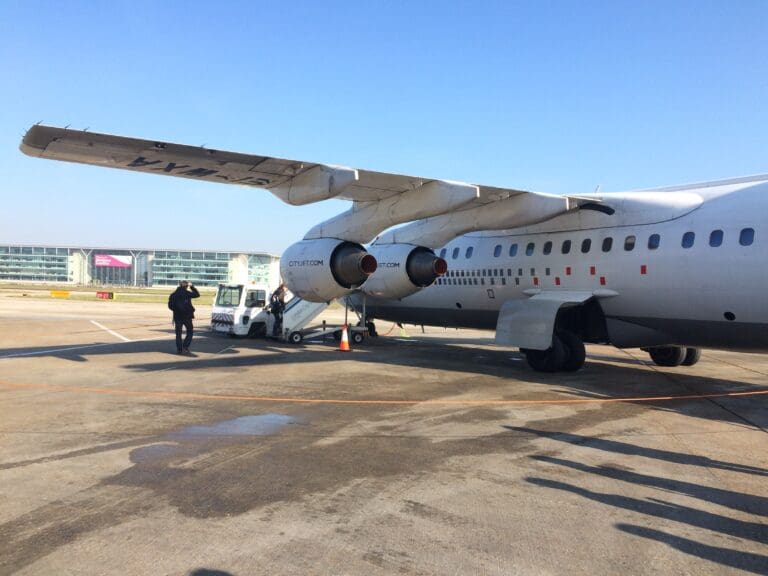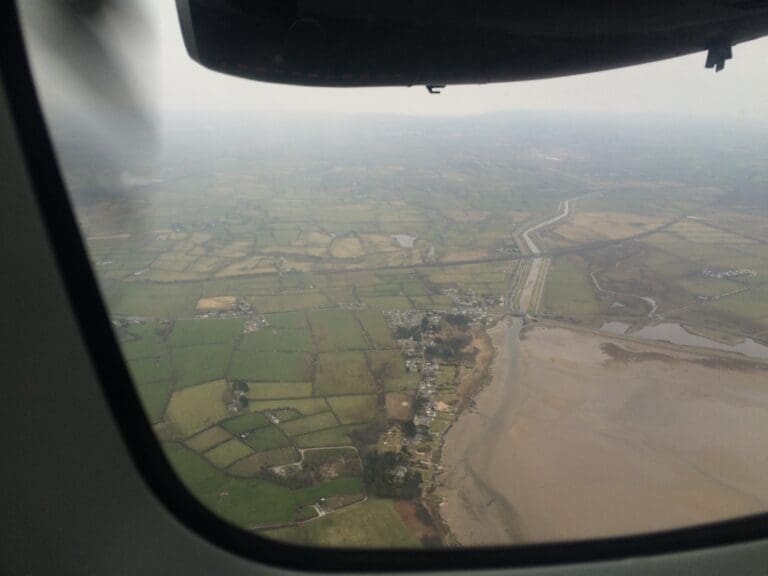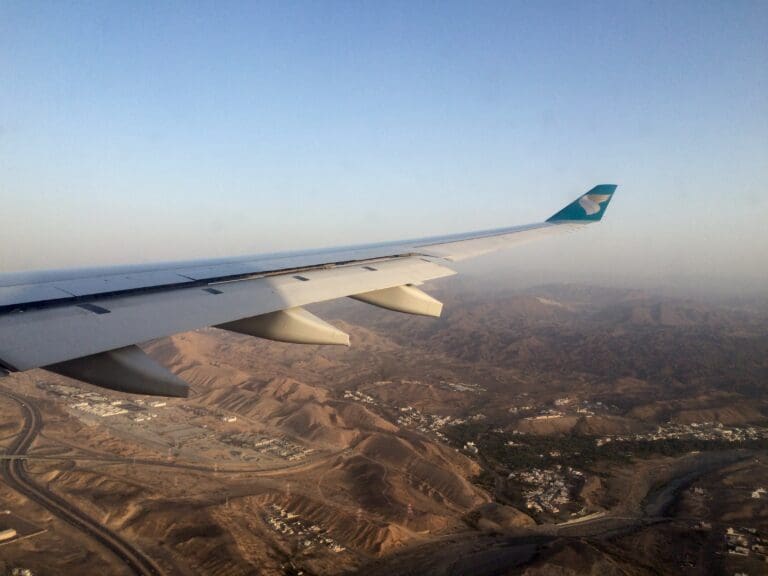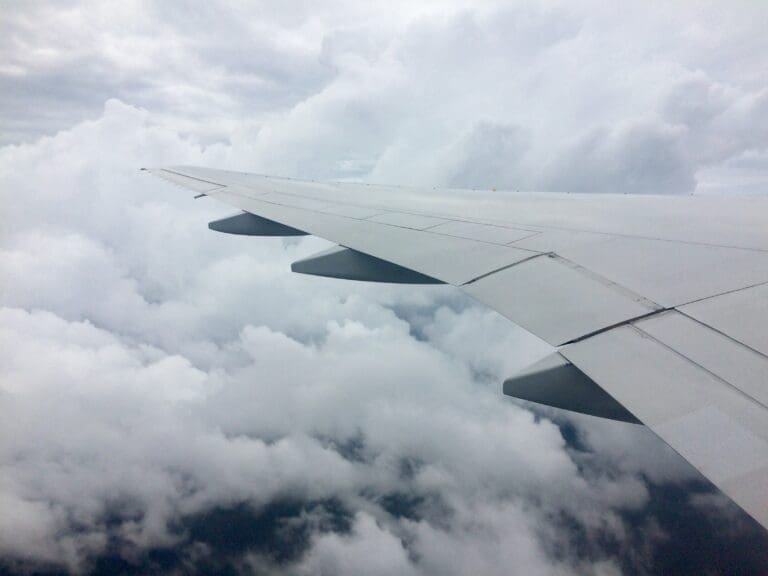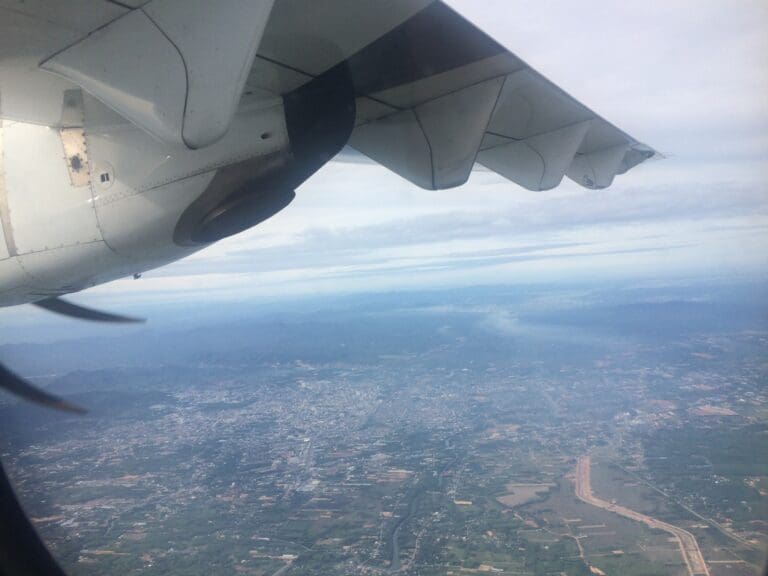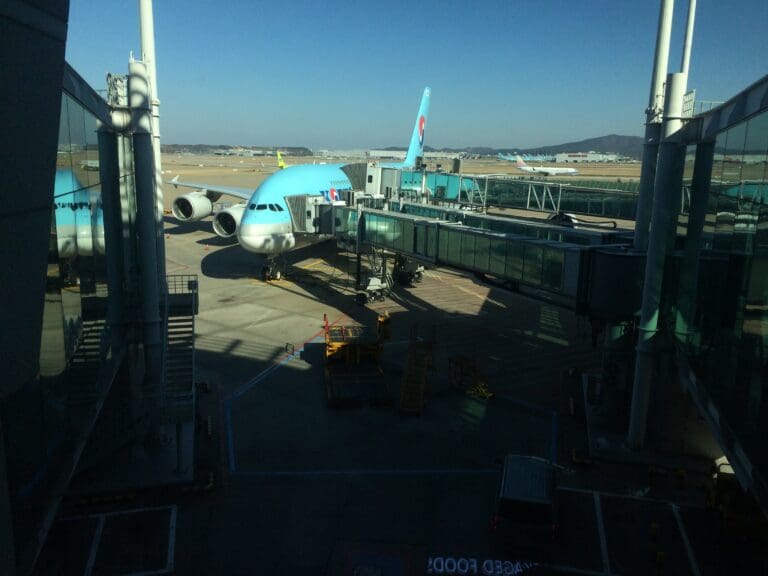EasyJet Review: Flying the Big Orange Jet from Gatwick to Glasgow
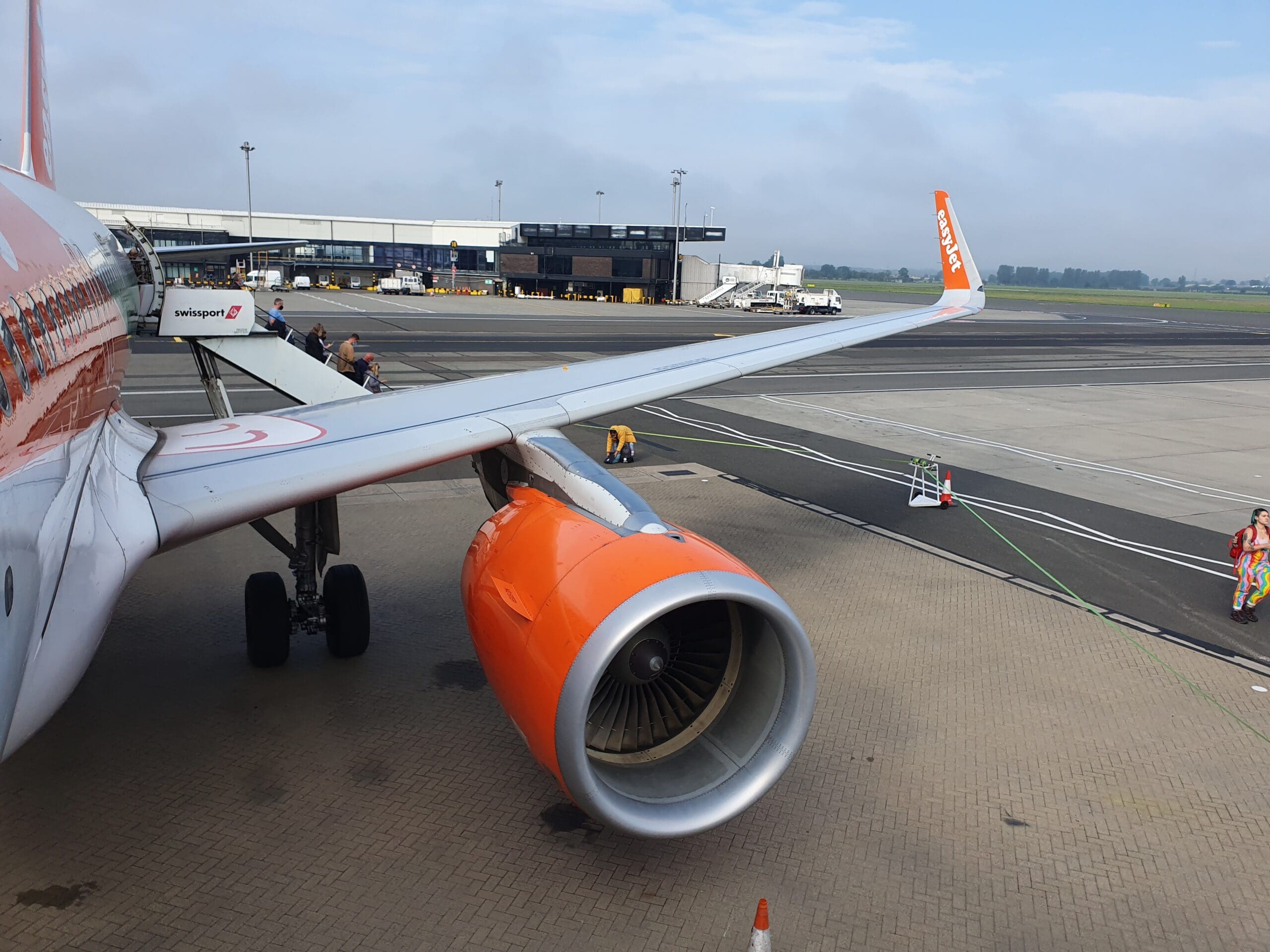
Background and Booking
In all ten flights I had taken with EasyJet before this trip, I had not experienced any issues with the airline. Just like their Irish competitor, I had always found EasyJet to do what it says on the tin – transporting me from A to B cheaply and with minimal fuss. Granted, whilst I was yet to experience anything about EasyJet that makes it stand out from other low cost carriers, I had nothing negative to say about them either. Living in London but making a trip to Scotland’s Outer Hebrides, I needed to find a cost-effective means of reaching Glasgow. From there I would head to Oban to fly on a Hebridean Air Services Britten-Norman Islander, before catching a ferry to Barra from where I would fly back to Glasgow onboard a Loganair Twin Otter.
Unless I fancied spending eight hours on a Megabus, EasyJet provided the cheapest means of reaching Scotland’s largest city, beating BA CityFlyer and British Airways’ services and rail options by quite some way. Without hesitation, I decided to book with EasyJet. Seeing as I still had the carrier’s app on my phone from my previous flight to Inverness, I opened this up and searched for flights between London and Glasgow on my chosen departure day. Within seconds I was presented with seven options – three departing Gatwick, two from Luton and two from Stansted. Living in West London at the time, reaching both Gatwick and Luton on public transport is not particularly difficult, and in the end, I settled for the carrier’s 0915 departure from the former. The base fare for this option amounted to a total of £26.99, however as is the norm with low cost airlines I was then presented with a wide variety of additional extras. These included hold luggage, priced at £19.99 and £22.49 for a 15kg and 23kg bag respectively, and sports equipment for £37.00 and/or £45.00. Fortunately, planning on only taking a small rucksack, I passed on both options and made my way to the passenger details page. Once I entered all my information, I was then taken to the second optional extras page where I had the option of selecting seats and adding a rental car.
Hoping for a window seat, the only way of guaranteeing this given EasyJet’s random seat allocation was to pay for this in advance. The cost of doing so ranged from an acceptable £4.99 right up to £23.49 for seats in the front and emergency exit rows. In the end, I splurged £4.99 for Seat 7F, the furthest forward seat available at this price. My reasoning for choosing this seat, was that in the event of clear skies, I would get a decent view of my hometown, Sheffield. Whilst Easyjet does not inform passengers of the aircraft type scheduled to operate their flight during the booking process, upon selecting seats the 31-row seat map indicated that the flight up to Scotland would be operated by an Airbus A320neo. After I had selected this seat and logged into my account, I proceeded to pay which was thankfully a glitch-free process and I received my booking confirmation and receipt almost immediately.
Check-in
Online check-in for all Easyjet flights opens thirty days before departure, however unlike Ryanair those who wish to check-in at the airport are not stung by a hefty airport check-in fee. Seeing as I had no reason not to check in via EasyJet’s app, I opened this with four days to go until departure and was immediately presented with the option to check in for my flight to Glasgow. Once I had confirmed my contact details, I was then given the option to add luggage and sports equipment, before being presented with a summary of my flight and a warning that the gate will close thirty minutes prior to departure. Seeing as I was flying domestically, no advanced passenger information was needed and so once I had agreed not to transport any prohibited goods I was presented with my mobile boarding pass.
The Journey
Living near Ealing, there were several routes I could have taken to reach Gatwick Airport on the morning of my flight. In the end, I decided to purchase an anytime return ticket from City Thameslink to Gatwick Airport, setting me back £14.70 with a 16-25 Railcard discount. This would allow me to catch a Thameslink train from any station south of City Thameslink served by Thameslink services to Gatwick Airport. Not wanting to cut things too fine, I decided to leave home at 0500 and catch one of the first eastbound District Line services of the day from Ealing Common. Following a short walk along the near-silent pre-dawn suburban streets, I arrived at the station, tapped in and headed down to the eastbound platform. As I had hoped, the 0513 service arrived within a couple of minutes of my arrival and I was soon whisked off alongside a very small number of sleepy morning commuters. After several stops, the train soon entered the subterranean world beneath Central London and journeyed roughly parallel to the north bank of the River Thames. Sixteen stops and approximately forty minutes after leaving Ealing Common, the train gently pulled into Blackfriars Station where I disembarked along with just two other passengers.
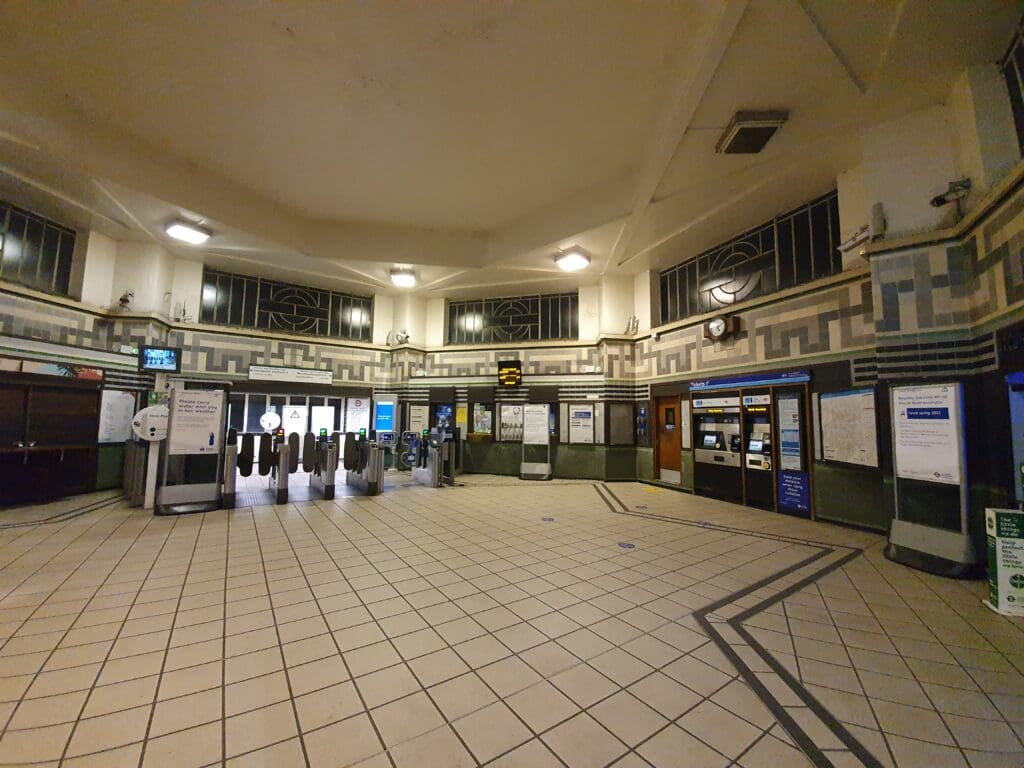
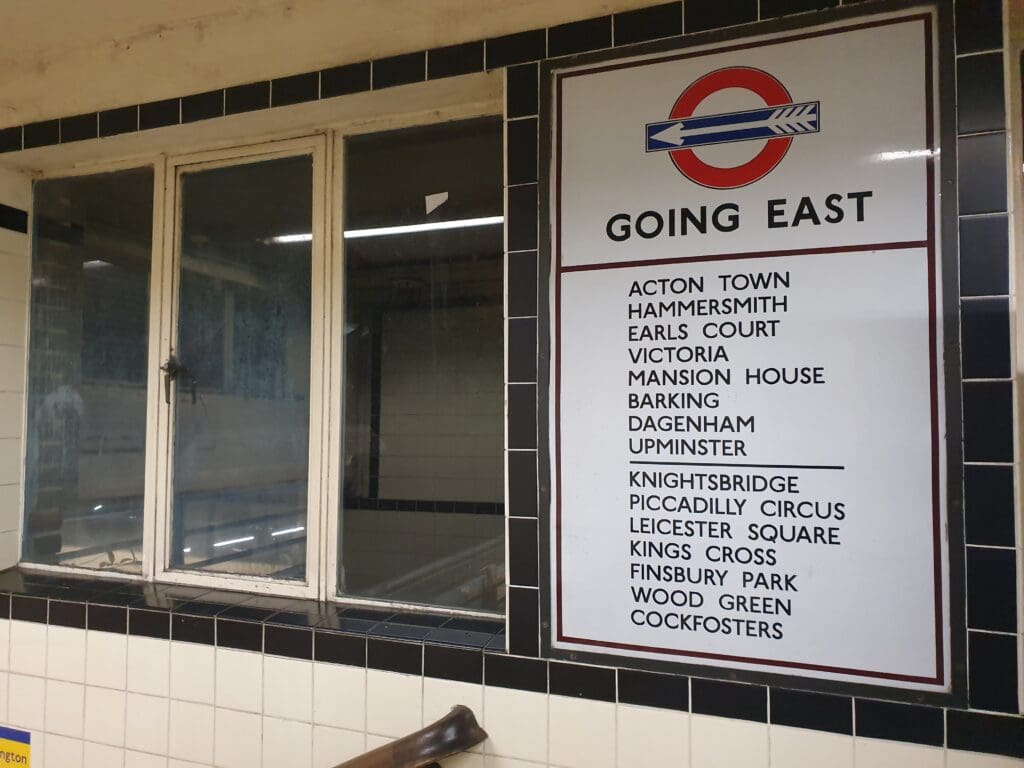
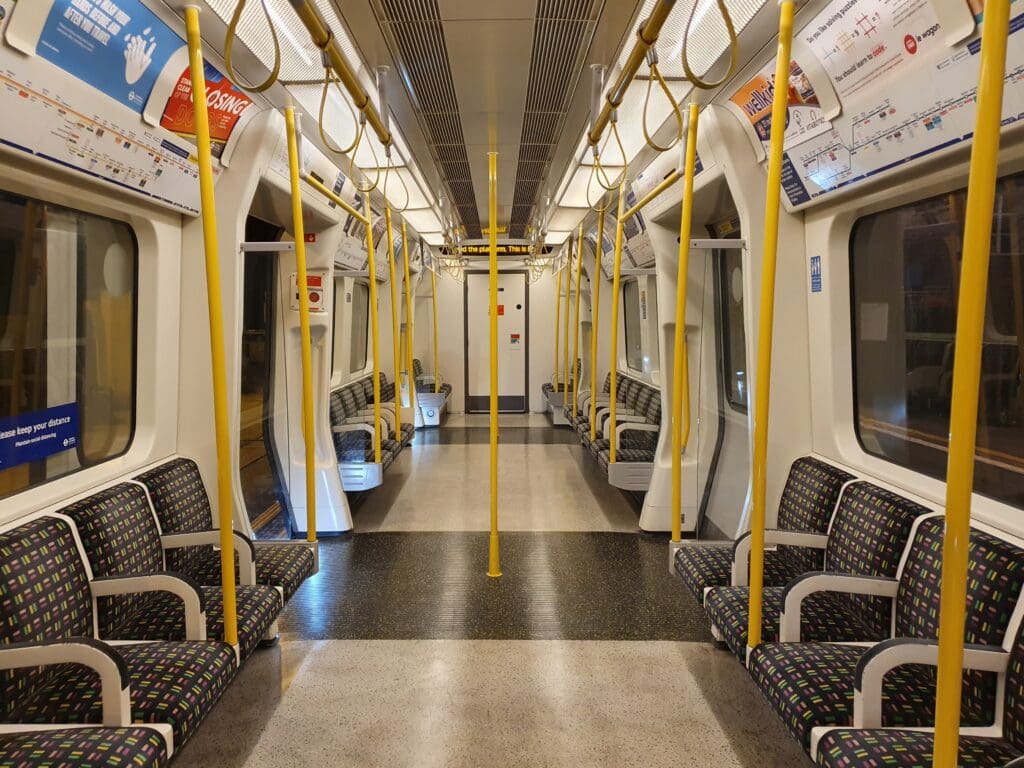
From the District Line platform, I headed up an escalator to the station’s main ticket hall where I tapped out before heading up to the southbound Thameslink platform. Sitting on Blackfriars Railway Bridge, from the southbound platform a good view of various London sights, including the Shard, St Pauls, Tower Bridge and Canary Wharf in the distance can be seen – the station thereby offering perhaps the most scenic views of any Central London station. Whilst Thameslink offer very regular trains between Central London and Gatwick Airport, passengers can end up on a slower stopping service as easily as they can end up on a quicker train that makes few stops as it journeys southwards. Having done my research, I had my sights set on one of the quicker services, and at 0557 a modern Siemens Class 700 train pulled into the station on its 103-mile journey from Bedford to Brighton. Once onboard, the train pulled away and cautiously proceeded towards London Bridge Station. Following a quick station stop, the train picked up speed as it made its way southwards through London’s suburbs before reaching East Croydon Station. From there, the train crossed into London’s green belt. Heading in the opposite direction to most commuters, only a handful of passengers could be seen in my carriage. Unsurprisingly, most were heading the same way as me and disembarked at Gatwick Airport where we arrived approximately 35 minutes after leaving Blackfriars.
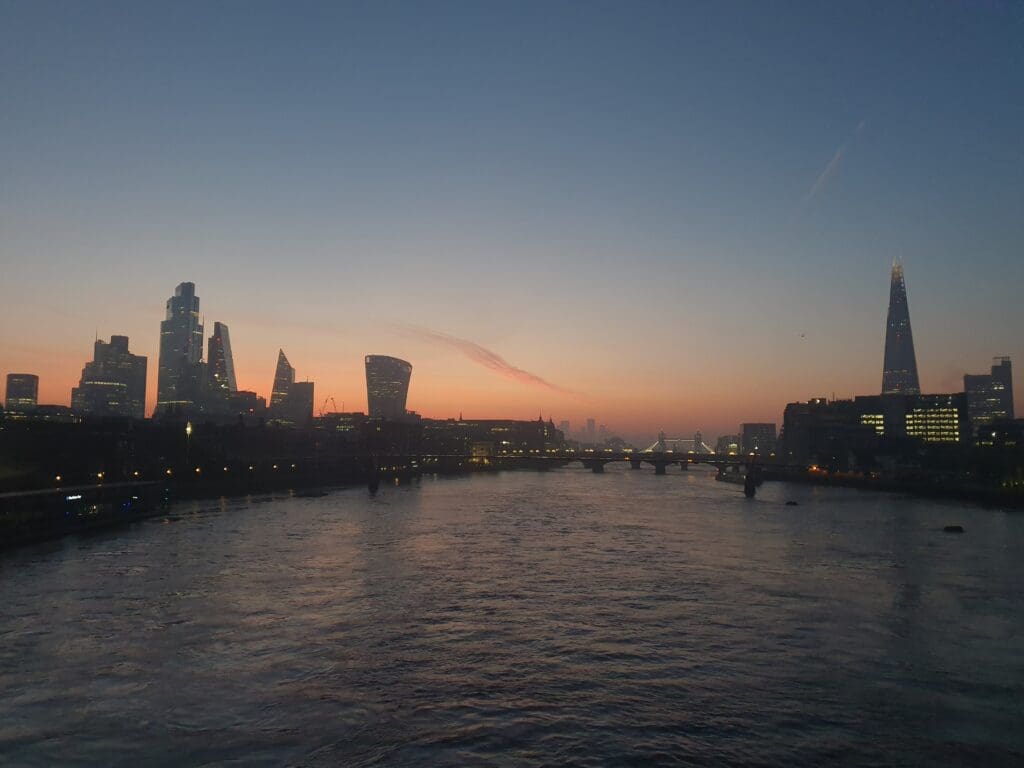
When it comes to airport stations, Gatwick Airport Station leaves little room for complaint. Connected to the South Terminal, and with the North Terminal easily reachable via a driverless shuttle train, this is undoubtedly one of the more convenient airport stations that I have passed through. Once through the manned ticket check, I inserted my ticket into the barriers and turned right, following signs for the North Terminal. After proceeding along a short passageway, I arrived at the station – having just missed a train, a two-minute wait was in store before I whisked over to the North Terminal. Around one hundred minutes after leaving home, I arrived at the North Terminal and headed up the escalators, entering via the doors located opposite the entrance of the security check. Seeing as I had my boarding pass in hand and with nothing to check in, I scanned my pass on the automated gates and made my way into the security area. Seeing as the morning rush was in full swing, this was unsurprisingly busy, however, with most checkpoints open, queues were minimal and I made it through the checkpoint quickly and painlessly within around two minutes.
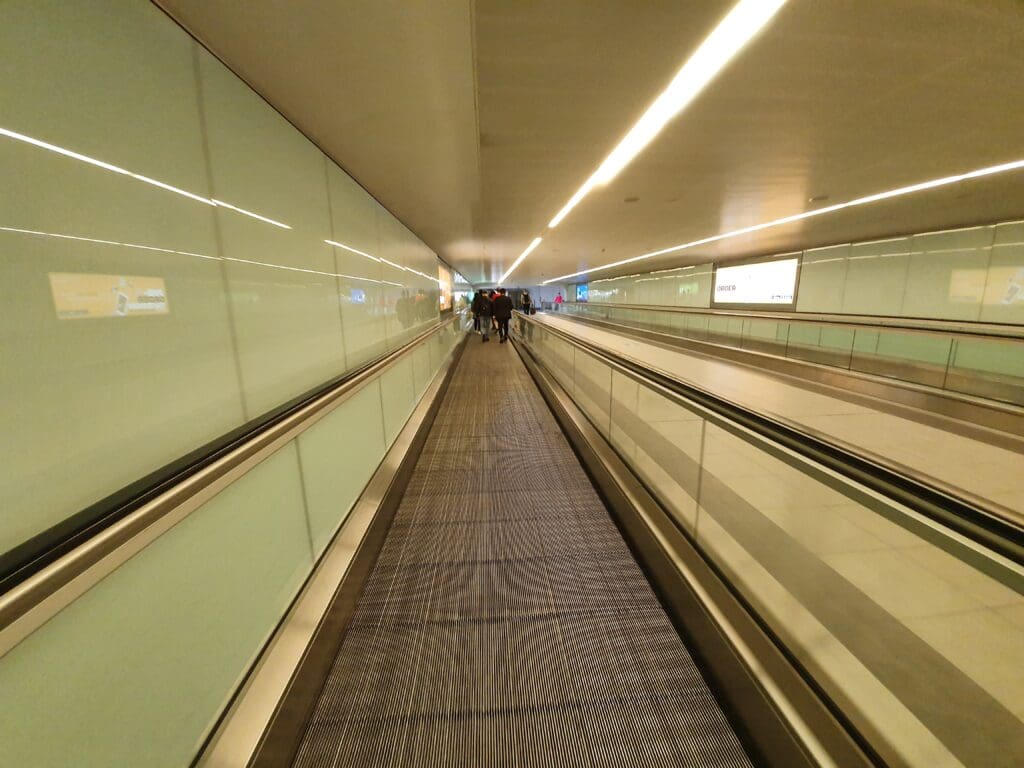

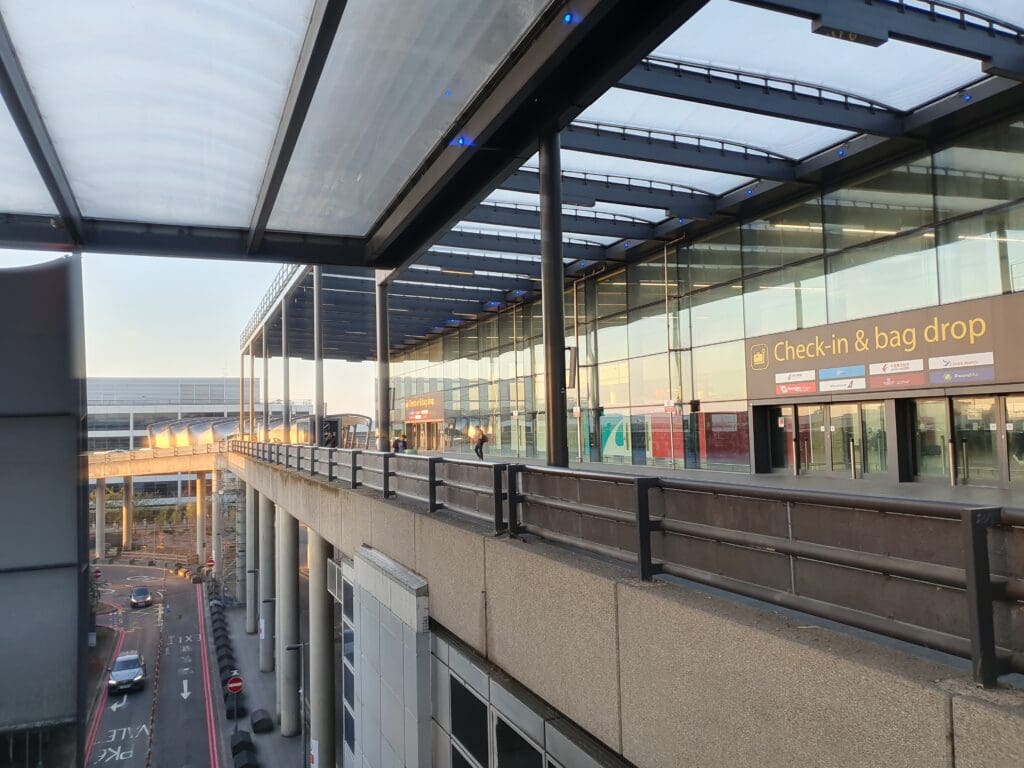
As is the norm at many British airports, passengers have no choice but to pass through the terminal’s main duty free area before entering the main airside departure area. Seeing as I had no intention of making any purchases, I sped through the shop and managed to avoid getting invited to sample a product. Whilst my flight was set to depart at the tail end of the EasyJet morning exodus, seeing as I had arrived early, the main airside departures area was reasonably busy with passengers jetting off to destinations mostly across Europe. Between my arrival in the airside departure area and my 0915 flight to Glasgow, a respectable total of 36 flights could be seen on the departure boards. As expected, the overwhelming majority of these were operated by EasyJet, followed by TUI Airways. Meanwhile, one flight each operated by Aurigny, Ryanair and Vueling could also be seen, alongside the highlight of the morning – a EuroAtlantic Airways Boeing 767 operated charter flight to Houston.
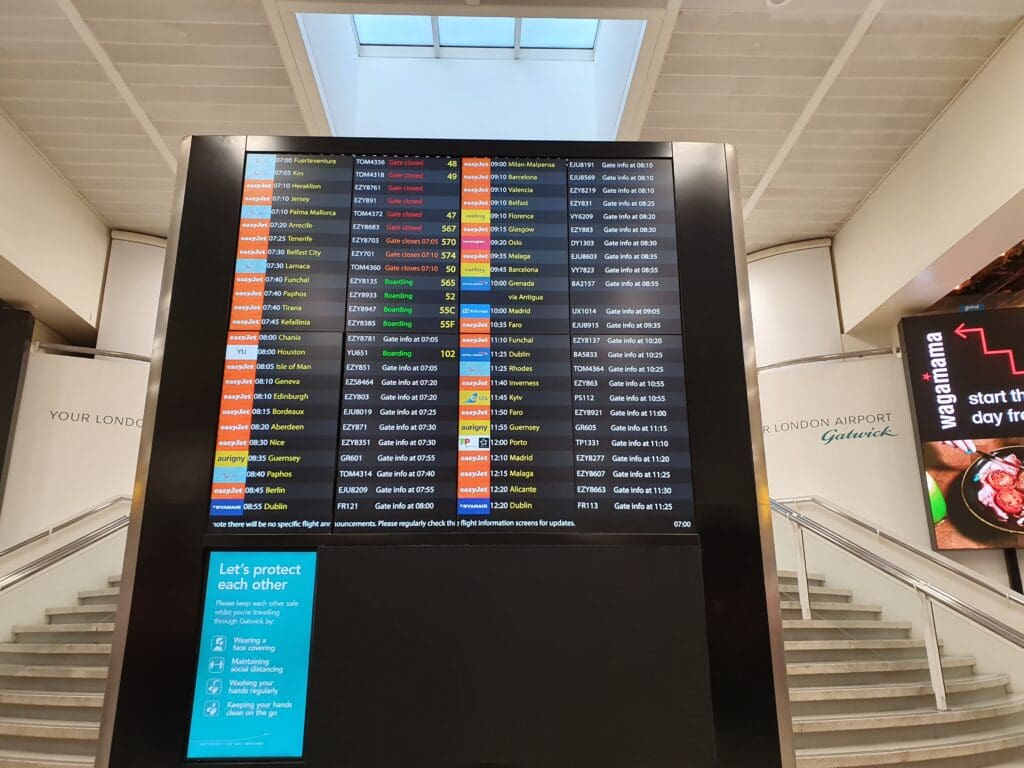
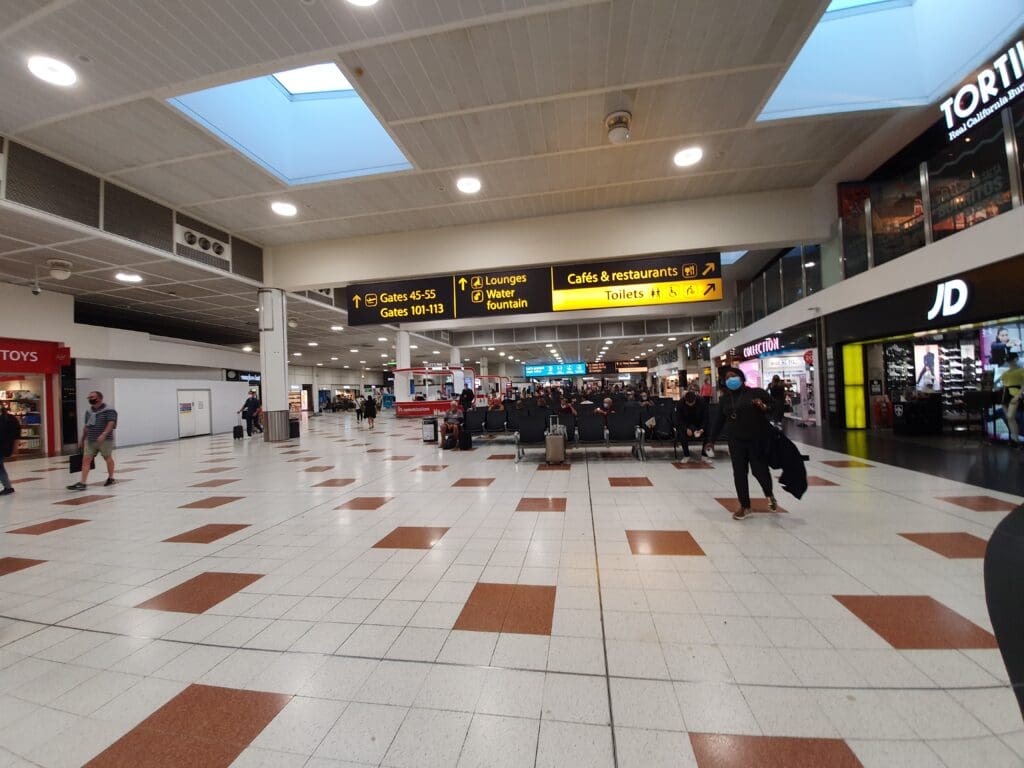
For those looking to pass the time, the North Terminal is home to a good number of cafés, restaurants and shops – of which, I would estimate around 75% to have been open that morning. Turning to the terminal’s design, to be rather frank, the terminal appears to lack any notable features (aside from the bridge over the apron!) although importantly I found this to be fairly clean, and the complimentary wifi worked well throughout. However, aviation enthusiasts may be a little disappointed to hear that few views of the action outside can be had from the main waiting area and gate numbers are not announced until a short time before departure. Therefore, after grabbing a cappuccino from Starbucks I headed over to one of the empty gate areas which offered an okay view of the action outside.
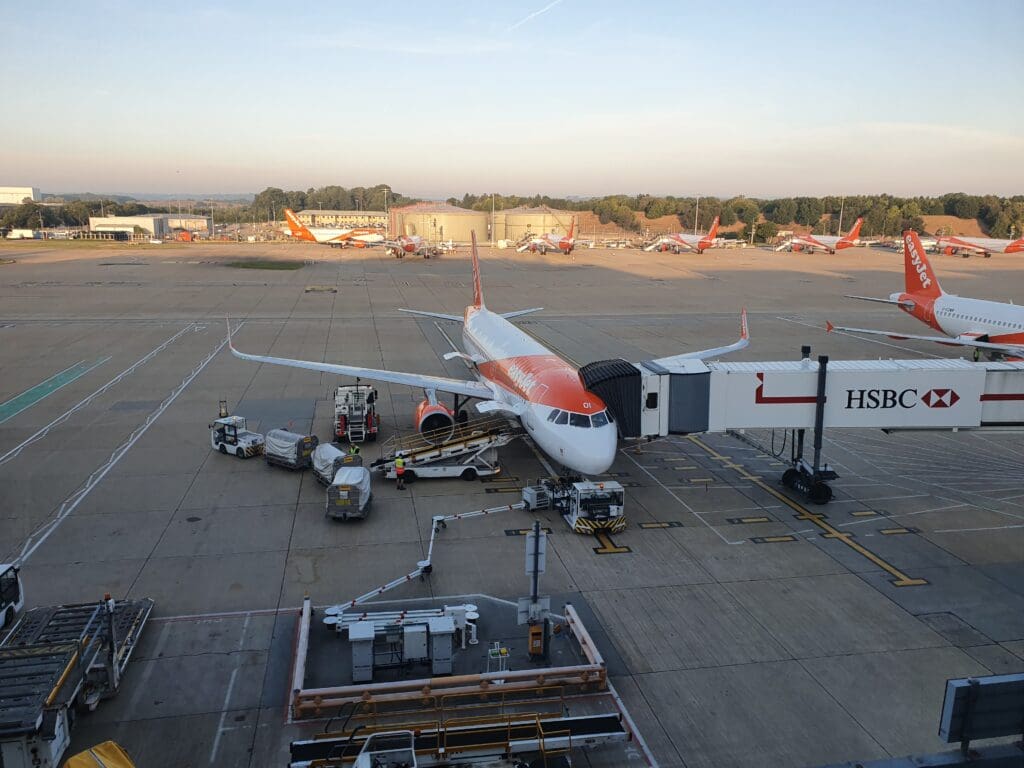
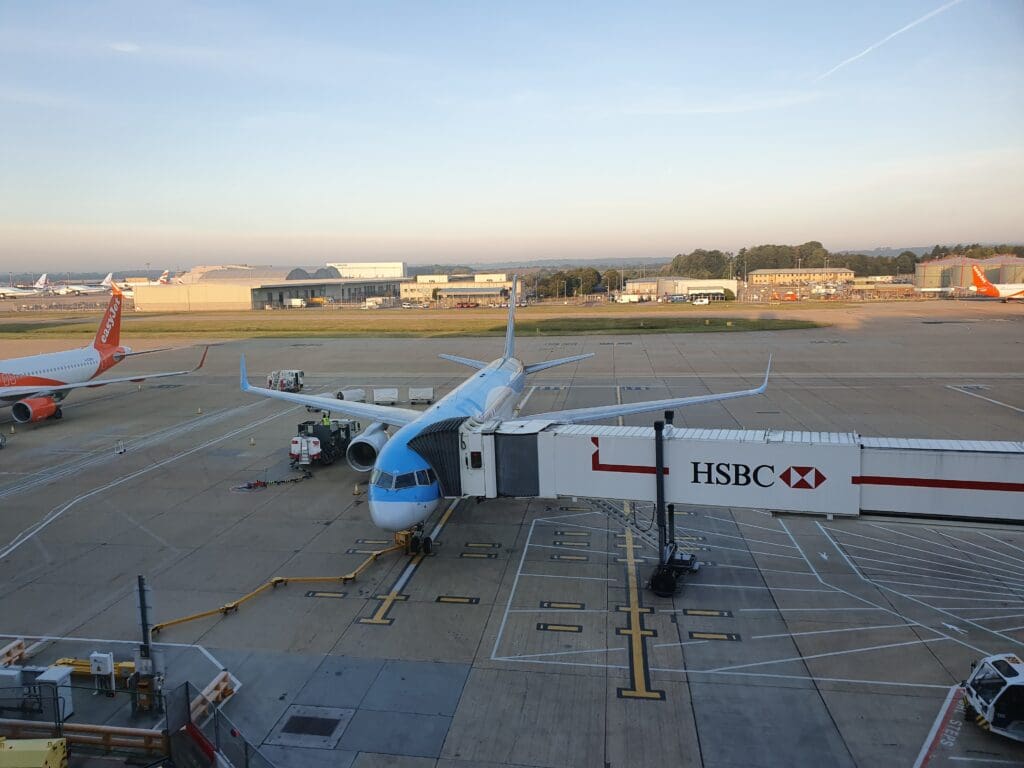
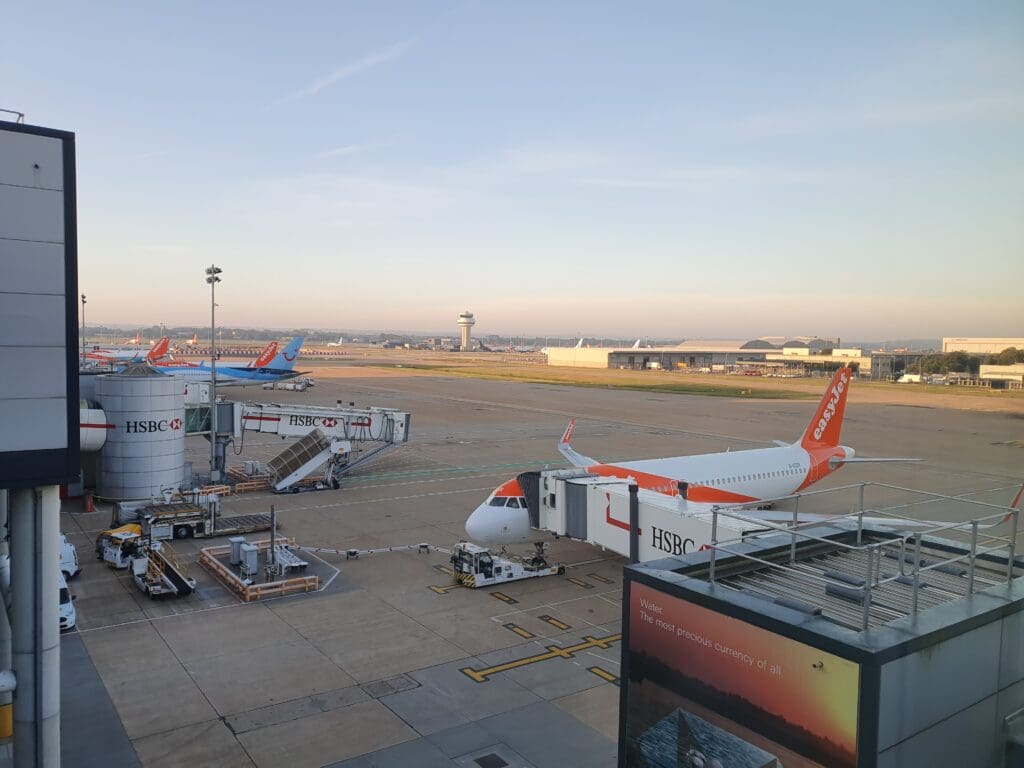
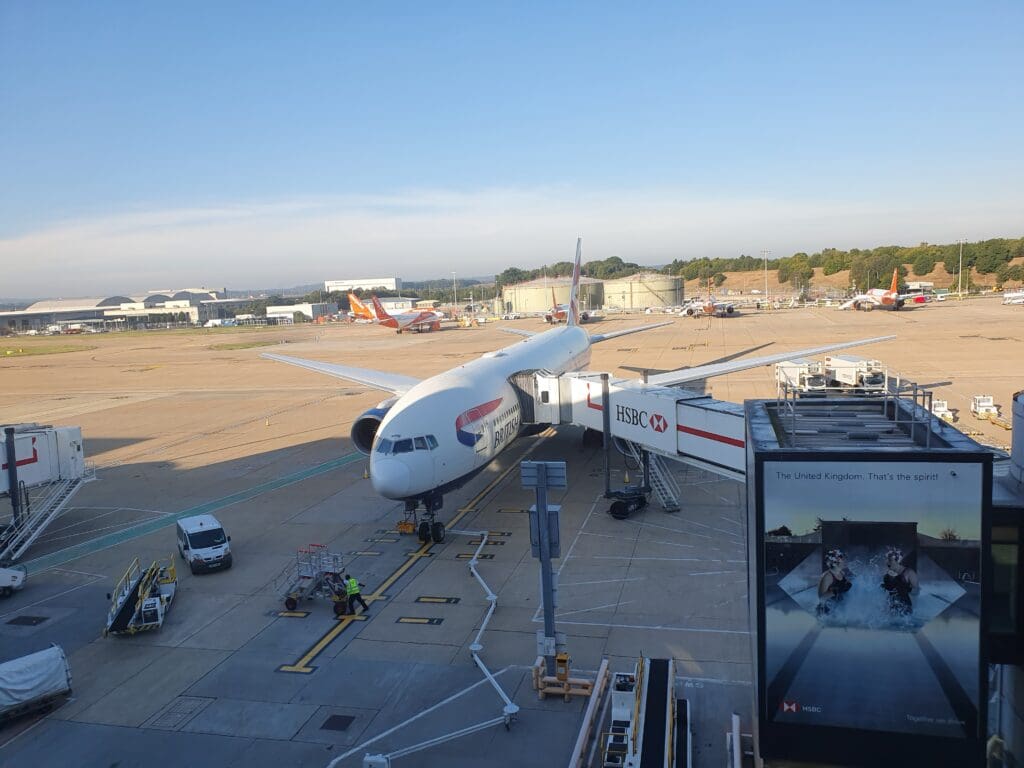
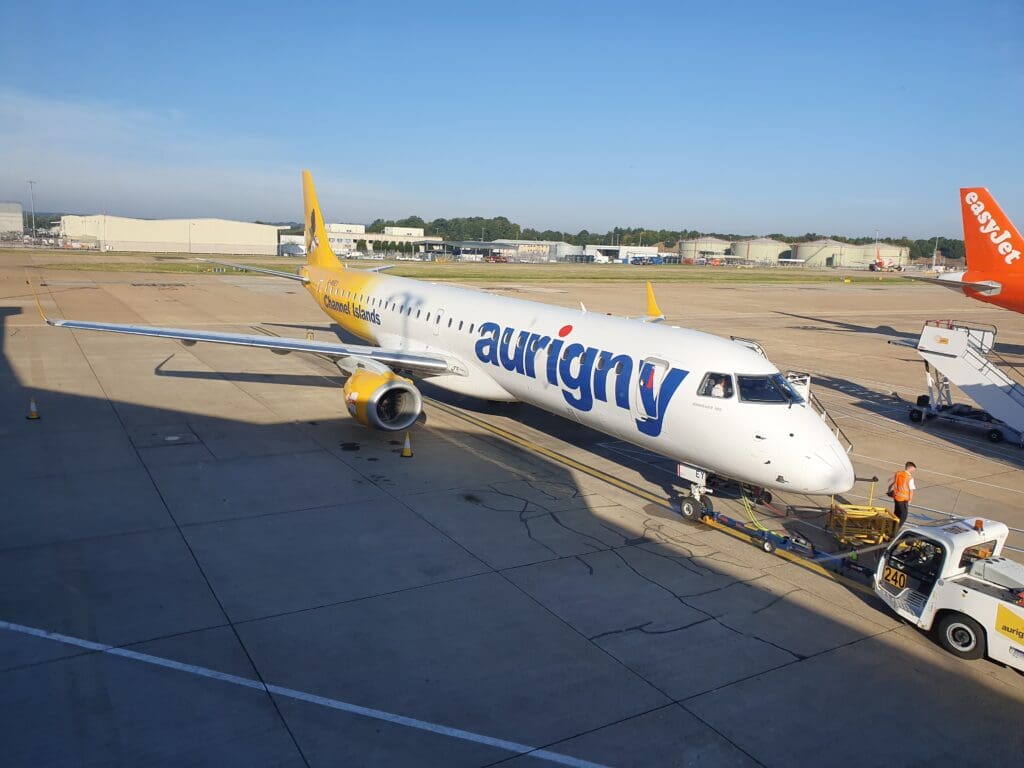
Despite the seat map for my flight implying that an Airbus A320neo would be operating the flight up to Glasgow, that morning as I tracked the progress of the inbound flight, it turned out this would be operated by Airbus A320-214 G-EZPD. Based in Glasgow at the time of my flight, as I waited I tracked the inbound flight heading southwards. This touched down in Gatwick at 0805, thirty minutes ahead of its scheduled arrival time before making a quick taxi over to Stand 553, corresponding to Gate 55F. Assembled at Airbus’ Hamburg Finkenwerder plant, this aircraft first took to the skies of Germany in late March 2016 with the test registration D-AUBX. This made the aircraft around five and a half years old at the time of my flight. Since summer 2016, this aircraft has worn special markings promoting car rental company Europcar. During its relatively short life, according to the AvHerald, the aircraft had been involved in one notable incident – this involving a bird strike on departure from Munich. Thankfully, things appear to have gone a little smoother since then and in the week before my flight, the aircraft had operated flights from both Luton, and then Glasgow having been transferred over to the EasyJet’s Glasgow hub. During this time, the Airbus operated a total of 32 flights, visiting Alicante, Amsterdam, Corfu, Edinburgh, Faro, Gatwick, Glasgow, Jersey, Lisbon, Luton, Malaga, Palma de Mallorca, Paris CDG and Stansted, covering at least 23,600 miles.
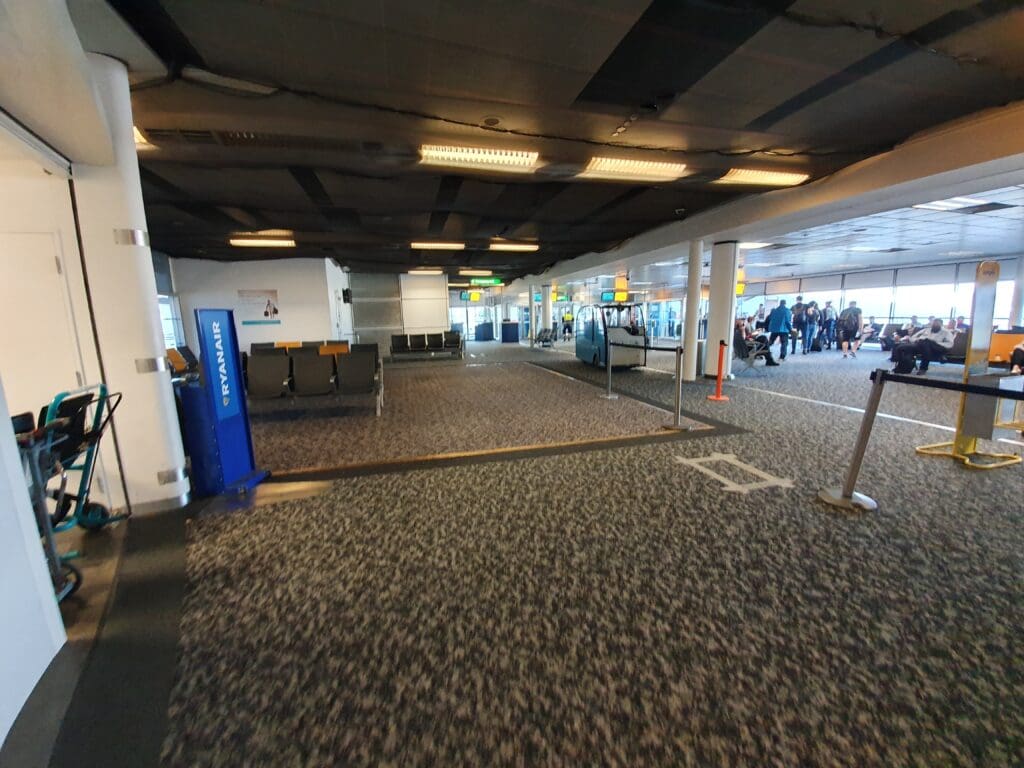
With fifty minutes to go before departure, the gate for the flight to Glasgow appeared on the departure boards and I also received a notification informing me of this on my phone. With no reason not to, I headed the short way over from the main waiting area to the small area home to gates 55A to 55K – these seemed to be reserved for those flights heading off to domestic destinations as well as those in Ireland. Upon arriving in this relatively small area, with two flights departing in quick succession – the other being an EasyJet service to Belfast, this area was relatively busy. Much to my surprise, upon arriving at the gate at 0930, boarding was already underway with those with Speedy Boarding making their way out to the aircraft. Within a couple of minutes, boarding for all other passengers was announced by one of the two gate agents shouting this, and I soon had my boarding pass scanned before I headed off down the jetbridge.
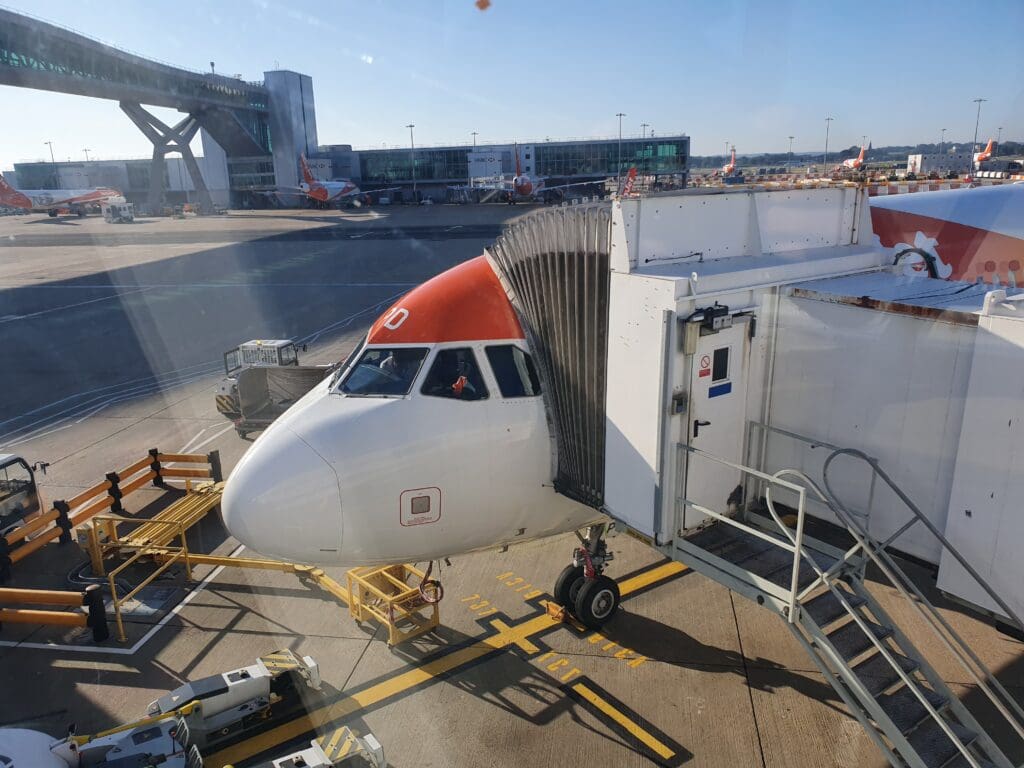
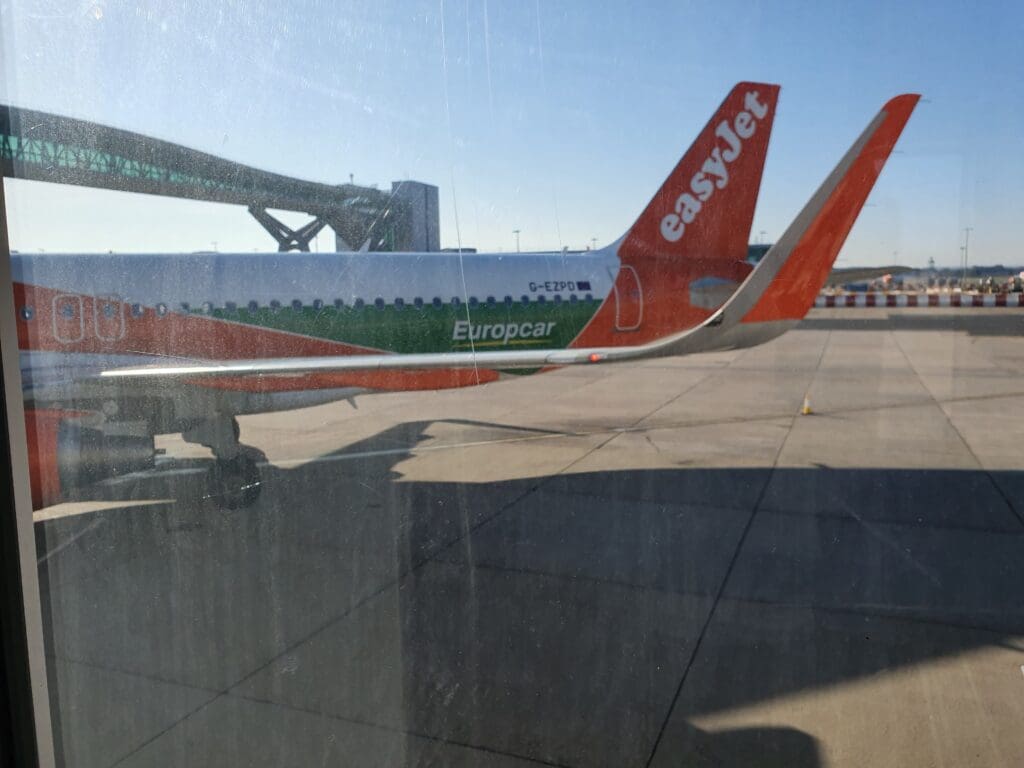
With minimal queuing, I soon arrived at the Airbus’ L1 door, the only door being used for boarding that morning. To the right of this, a gold-coloured decal could be seen that promoted EasyJet’s status as one of the world’s best low cost airline as per the 2019 Skytrax World Airline Awards, perhaps as a reaffirmation to passengers that they had made the right choice in opting to fly with EasyJet. As I stepped into the forward galley, I was given a very friendly greeting by one of the flight attendants onboard, which was followed moments later by an equally hospitable greeting from the Purser. Turning right, with few passengers in front of me I arrived at seat 7F in no time and easily slid into this.
Inside the cabin, G-EZPD features a total of 180 thin ironing board like Recaro SL3510 seats covered in an orange and grey fabric cover. On their backs, passengers can find a small tray table suitable for nothing more than drinks, snacks and a tablet, a pouch containing a safety card, a coat hook and an advertising window. Focusing on the latter, at the time of my flight these featured advertisements for Cadbury’s Caramilk bar – recently introduced to the UK market, Europcar and Uber Eats’ grocery delivery service. Standing at around 1.85 metres tall, whilst the seat was not particularly spacious, offering 29 inches of pitch, this was not significantly different from that of other low cost airlines. Furthermore, the seat itself seemed to be relatively soft – seemingly more so than on the EasyJet Airbus A320neo I had taken up to Inverness several months before this trip. All-in-all, in terms of comfort, the seat was acceptable given the length of the flight, however, I would be a little hesitant to travel in such seats on the carrier’s longer services to say Egypt or Jordan. Finally, I failed to spot any notable signs of wear and tear, and the cabin appeared to be spotlessly clean.
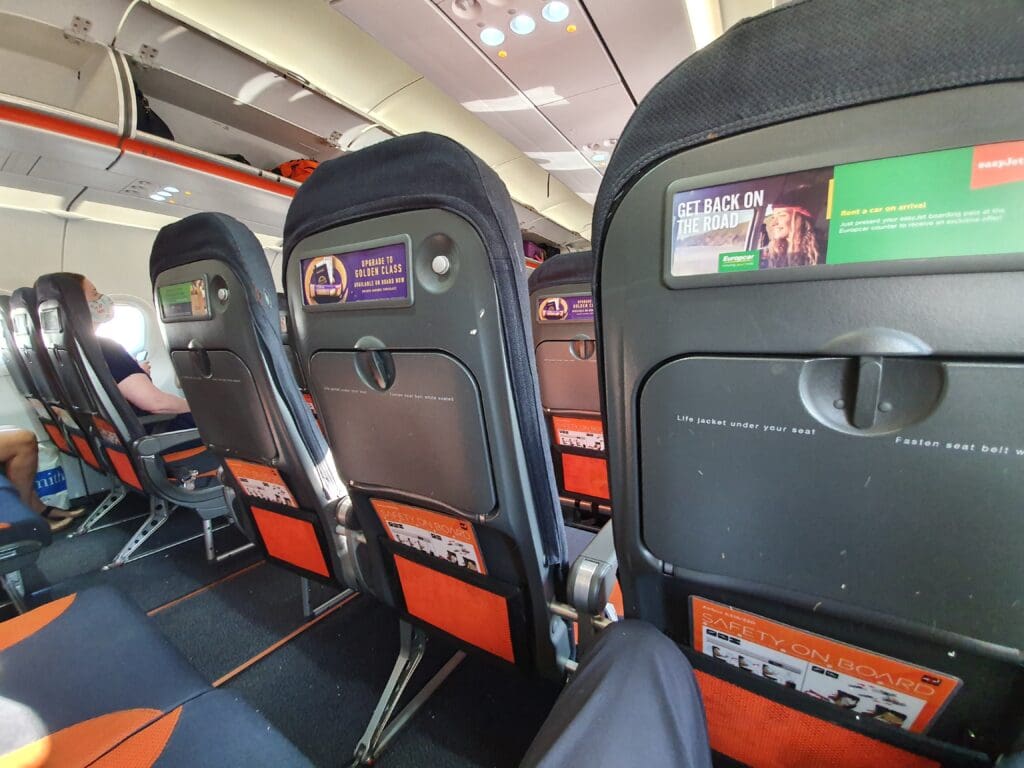
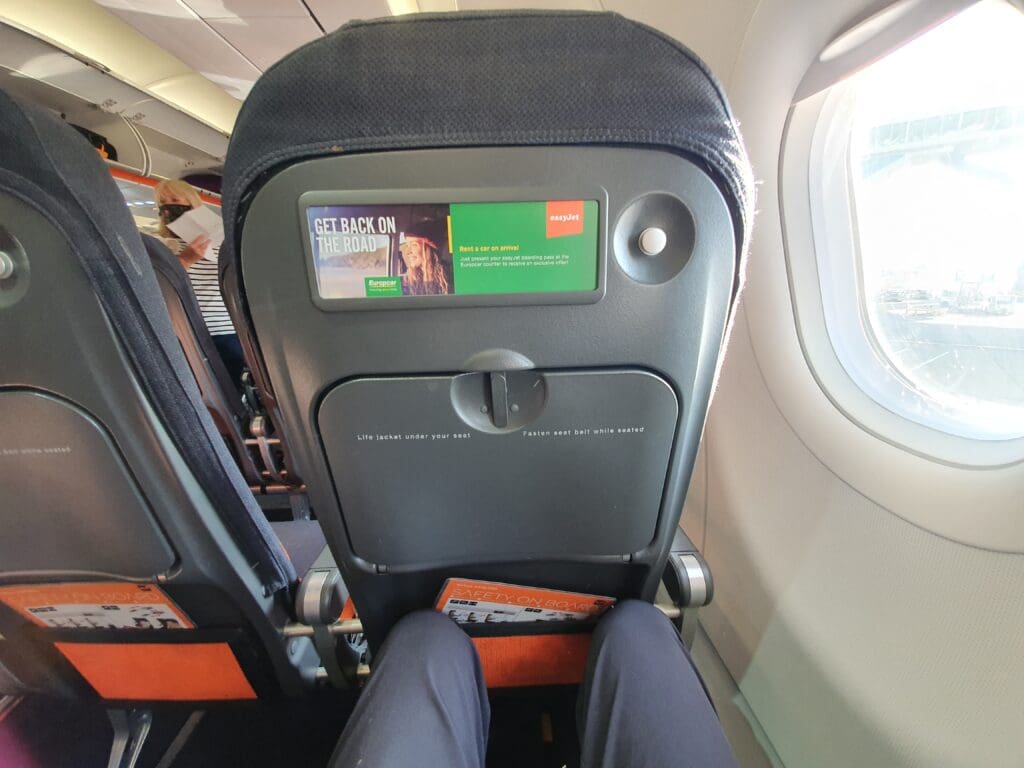
Having been in one of the first cohorts of passengers to board the jet, once I had made myself comfortable, passengers continued to pour into the cabin for some time. Unlike on Ryanair, no upbeat soundtrack accompanied boarding, however, the Purser did perform several announcements as passengers streamed onto the aircraft reminding passengers of EasyJet’s Covid rules, and requesting passengers keep their seatbelts unfastened as the aircraft was in the midst of being refuelled. Indeed, the latter statement aligned with what I could see outside my window, meanwhile below a small number of bags could be seen being placed into the hold. Some further excitement was to be had when a fellow EasyJet Airbus A320 pulled into the neighbouring stand after a long flight from…Gatwick. This particular aircraft had departed Gatwick earlier that morning and had been scheduled to fly down to Jersey, however, following several holding patterns around the Channel Islands, the aircraft returned to Gatwick without touching down – presumably owing to weather reasons.
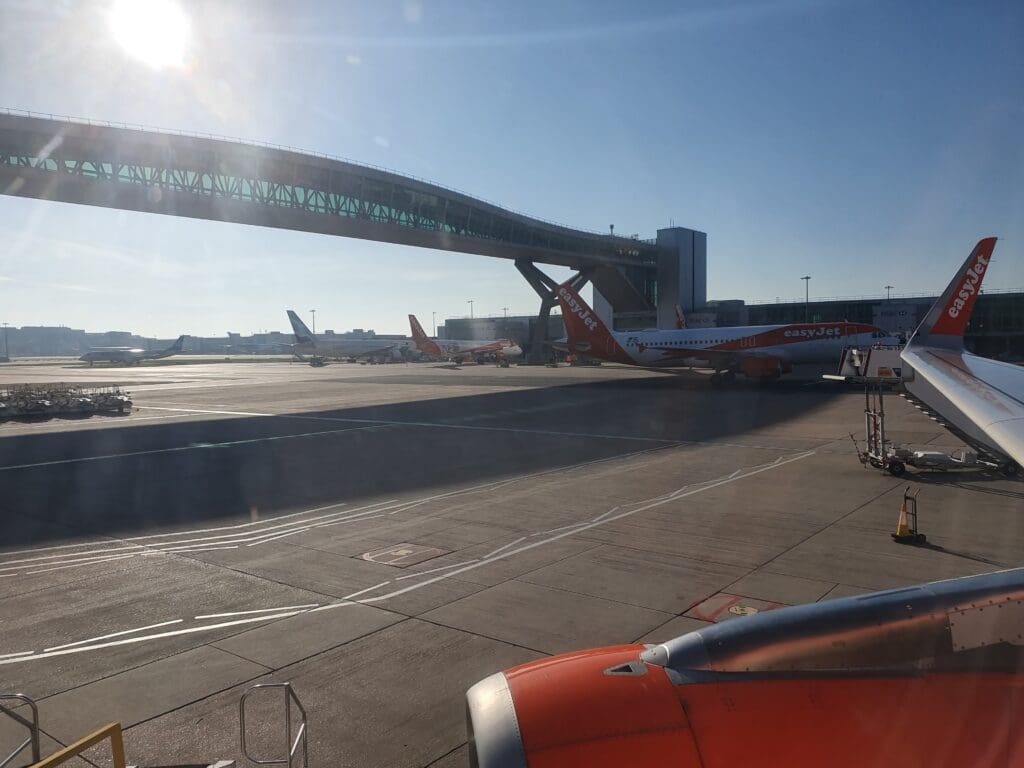
Around fifteen minutes after I had taken my seat, I was joined by the aisle seat occupier, and by 0900 the final stragglers had made it onto the aircraft – with this confirmed by the ‘boarding complete’ announcement. That morning, the flight appeared to be around 80% full with the flight’s demographic taking the form of a mix of both business and leisure flyers. At 0905, the Scottish Captain performed a short welcome announcement, introducing both himself and the first officer, mentioning that the latter pilot would be doing the flying that morning. This came in addition to the usual word of thanks for flying with EasyJet, as well as a brief mention of the one hour flight time and the fine weather en route. This was immediately followed by the Purser’s main welcome announcement. This featured all the usual welcomes and thanks, as well as an introduction of the four cabin crew members onboard that morning. This transitioned into the safety announcement, which consisted of the purser reading out the safety instructions and the three other flight attendants performing a demonstration in various points in the aisle.
Almost immediately after the safety demonstration reached its conclusion, at 0910 the aircraft was quickly yet gently pushed back and the two CFMI CFM56-5B4/P engines hummed and vibrated into life, temporarily filling the cabin with the scent of aviation fuel. Following a short pause, the tug was disconnected and four minutes later, the aircraft began its taxi to runway 08R as the cabin crew passed through the cabin undertaking their final pre-departure safety checks. Once away from the North Terminal, the Airbus passed through Gatwick’s remote stand area where the sorry sight of a host of temporarily stored British Airways and EasyJet jets could be seen. Moments later, the withered-looking G-CEXP, a Handley Page Herald that has been on the ground at Gatwick since experiencing an engine fire during taxi in July 1994 whilst operating for Jet2 predecessor Channel Express, came into view. This was followed by the airport’s fire trainer before our Airbus swung left and taxied onto Runway 08R.
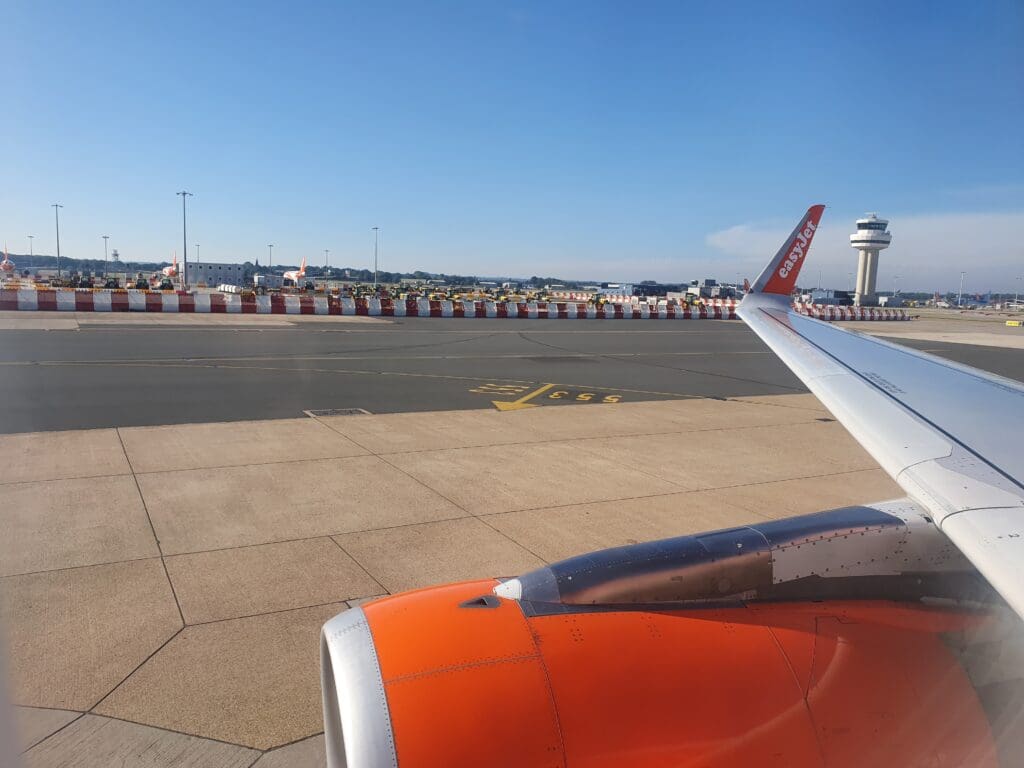
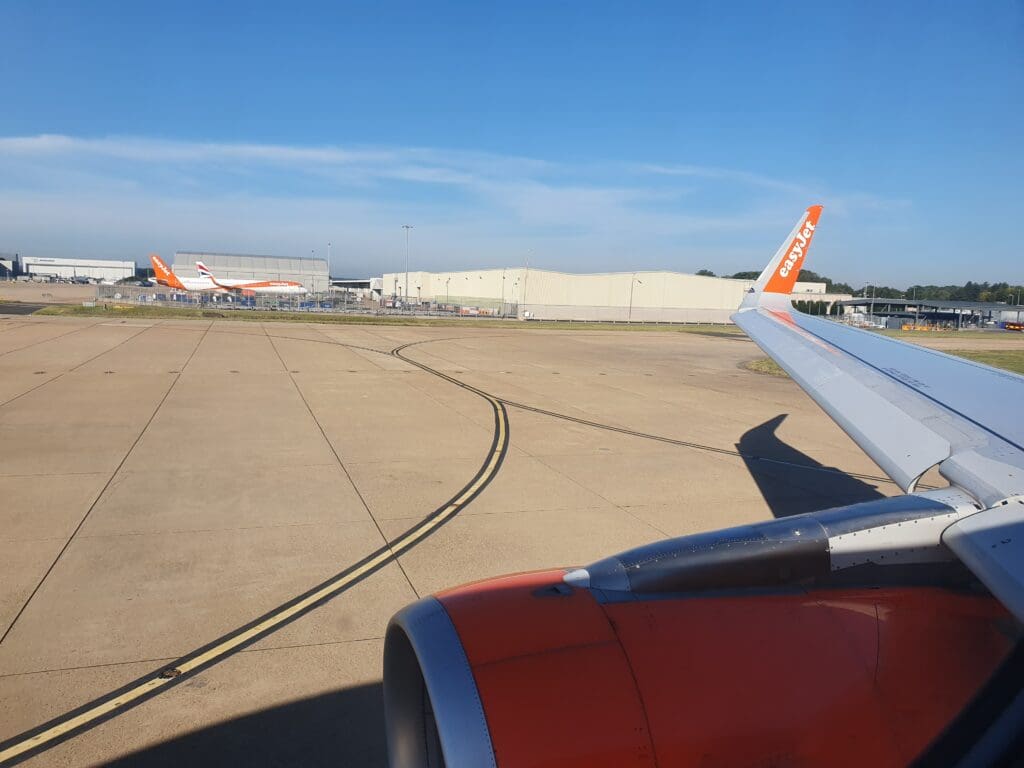
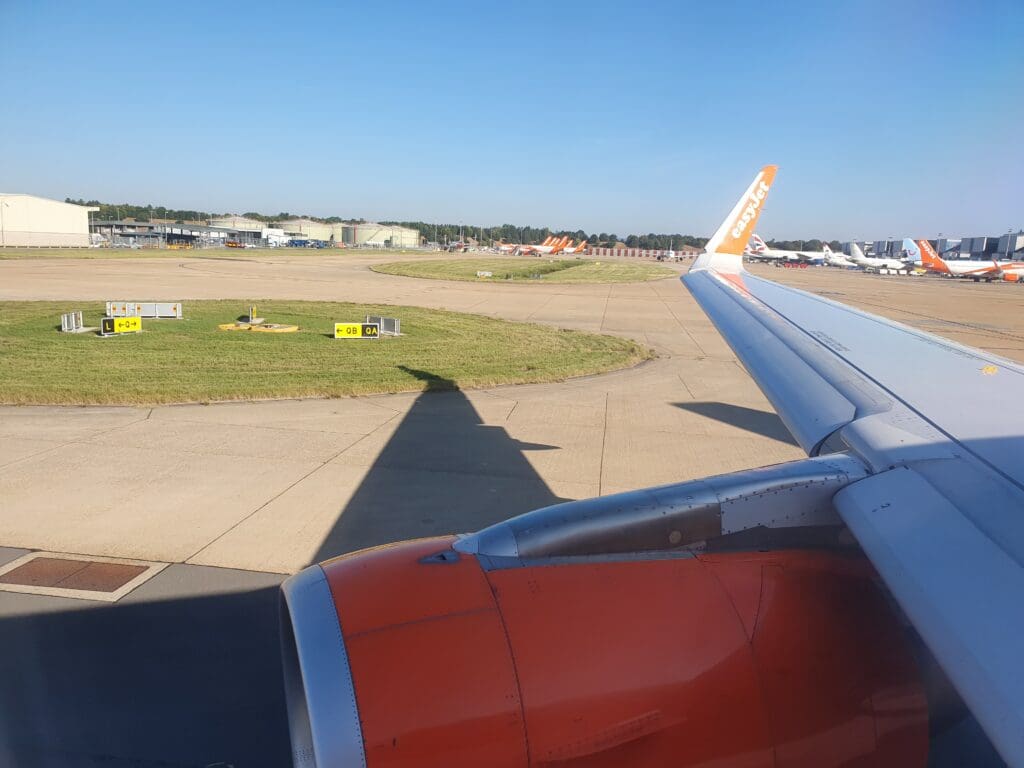
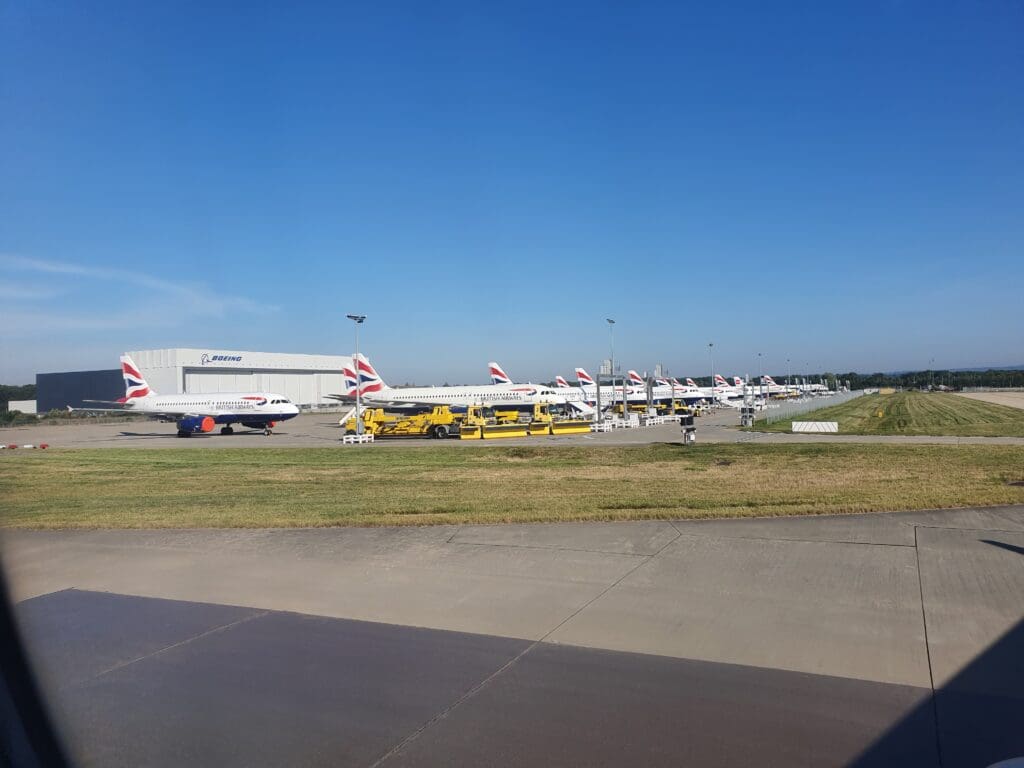
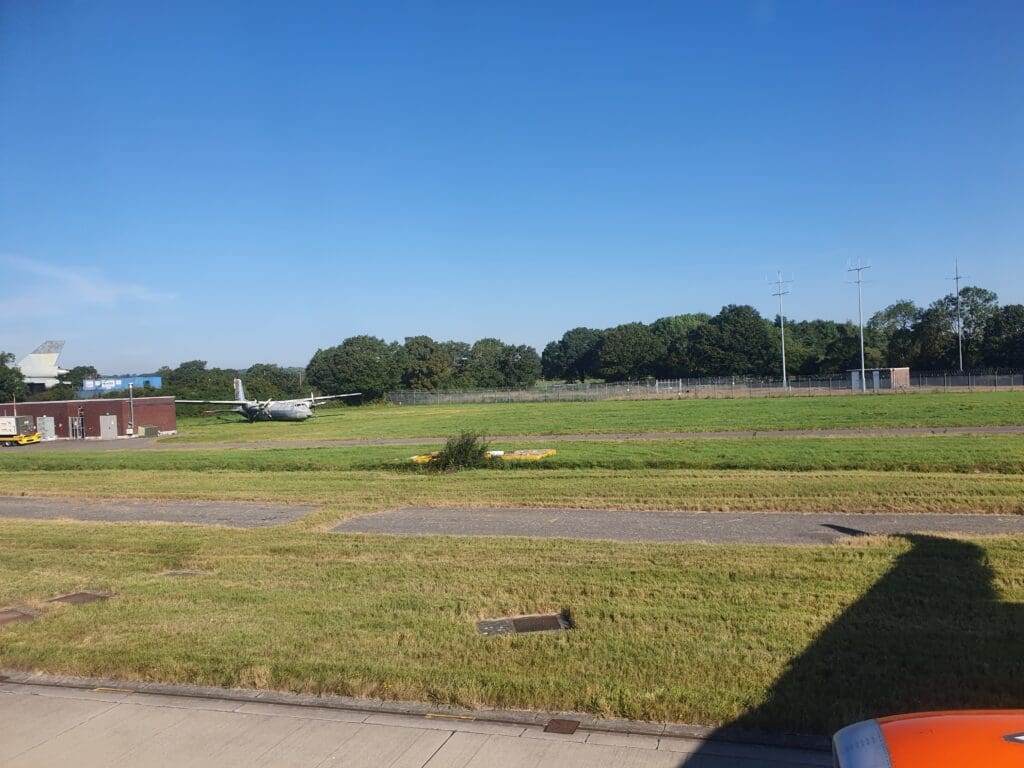
Without any pausing, at 0921, the cabin filled with noise and ‘Easy 787 Papa’ commenced its powerful takeoff roll, soon rotating up into the sunny blue skies of West Sussex. Seeing as the aircraft had departed into the east, and sitting on the right hand side of the aircraft, during departure I was not offered any views of the airport and was instead treated to views of the carparks and offices located along the southern perimeter fence. Once up in the skies, the nearby town of Crawley as well as the industrial estates, forests and fields that surround the airport could also be seen.
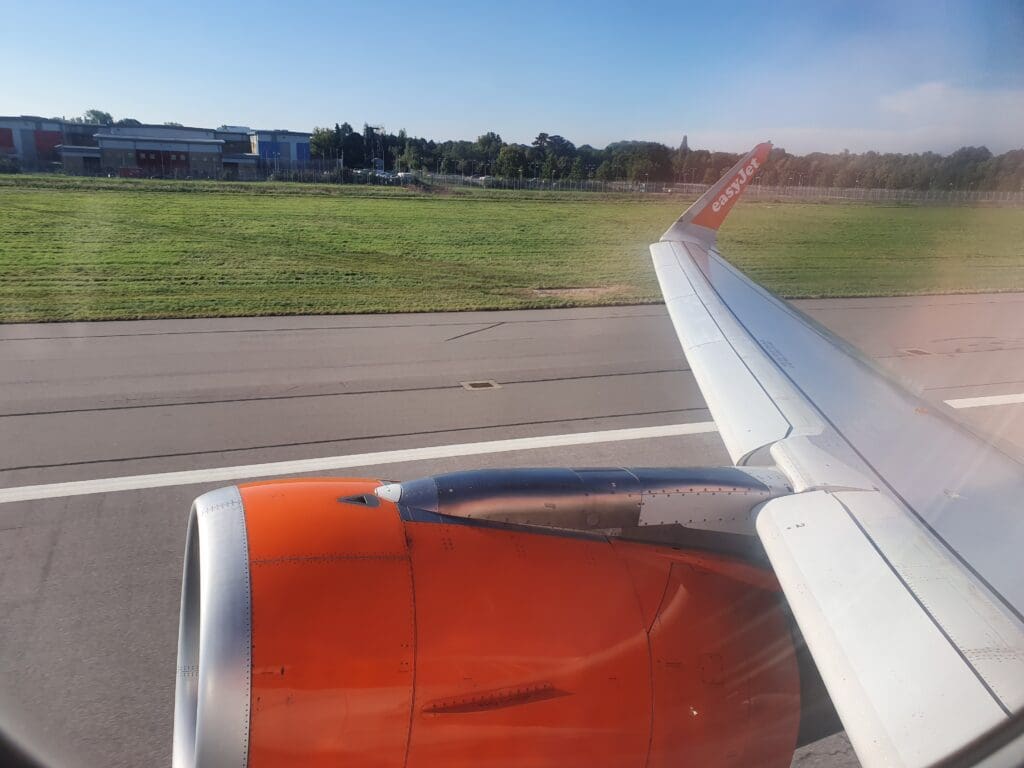
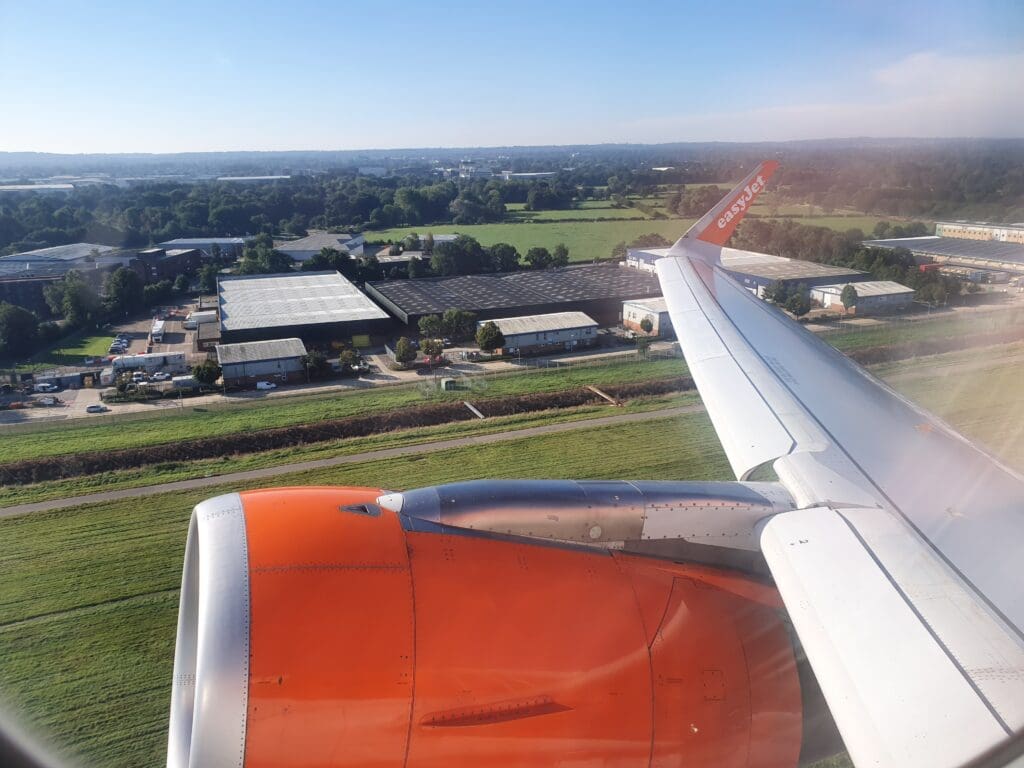
Once leaving the airport behind, with minimal banking the Airbus proceeded towards the Kent town of Sevenoaks, passing just to the south of this. From there, the aircraft turned northwards towards Dartford, offering views of the North Kent Marshes, Thames Estuary and English Channel in the distance. As the aircraft passed through 10,000 feet, the seatbelt signs were extinguished and the purser soon performed the usual announcement regarding keeping seatbelts fastened whilst seated and the imminent commencement of the EasyJet Bistro service, as well as the relatively recent addition to this – a warning regarding facemasks and queuing whilst waiting to use the onboard lavatories.
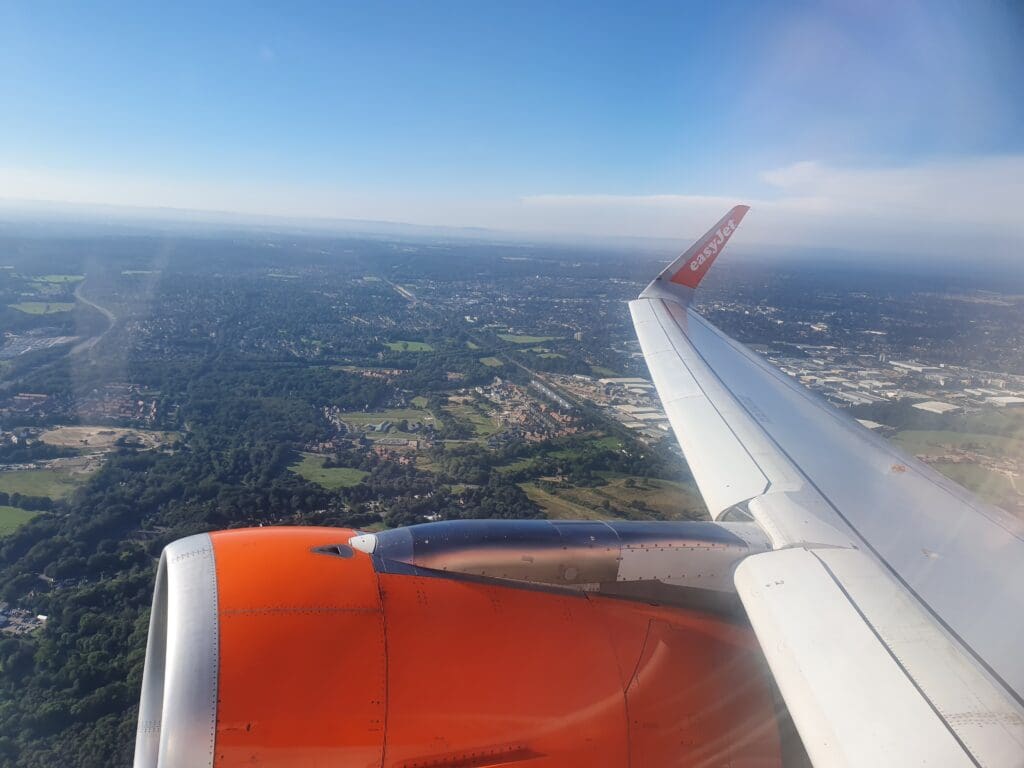
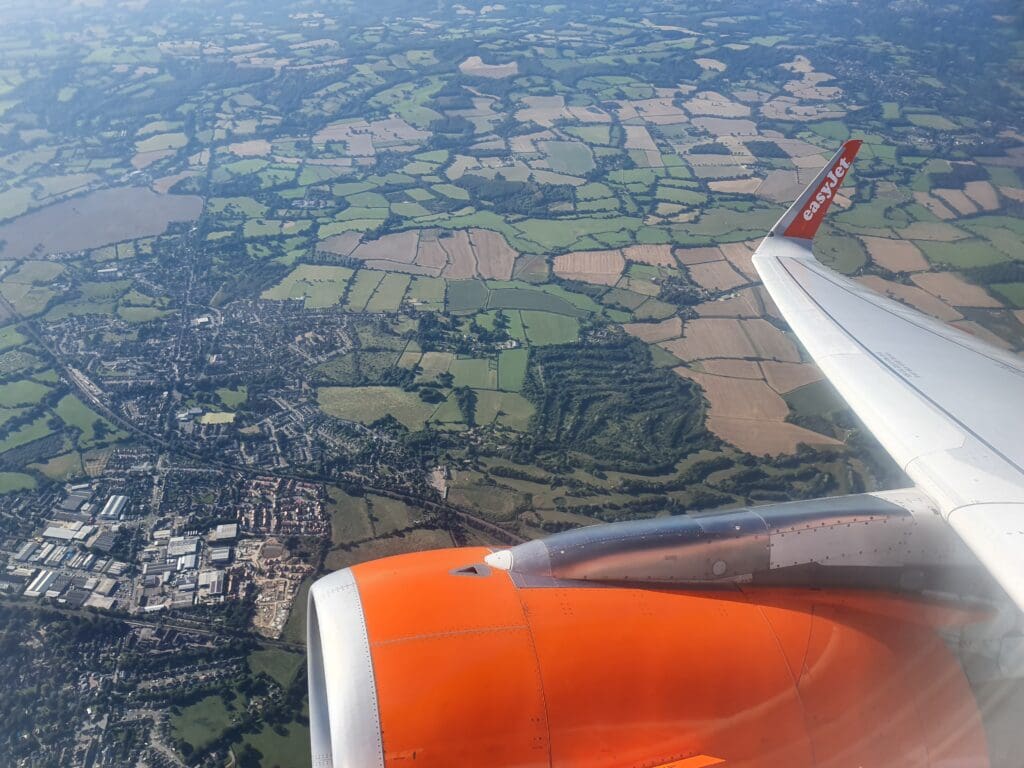
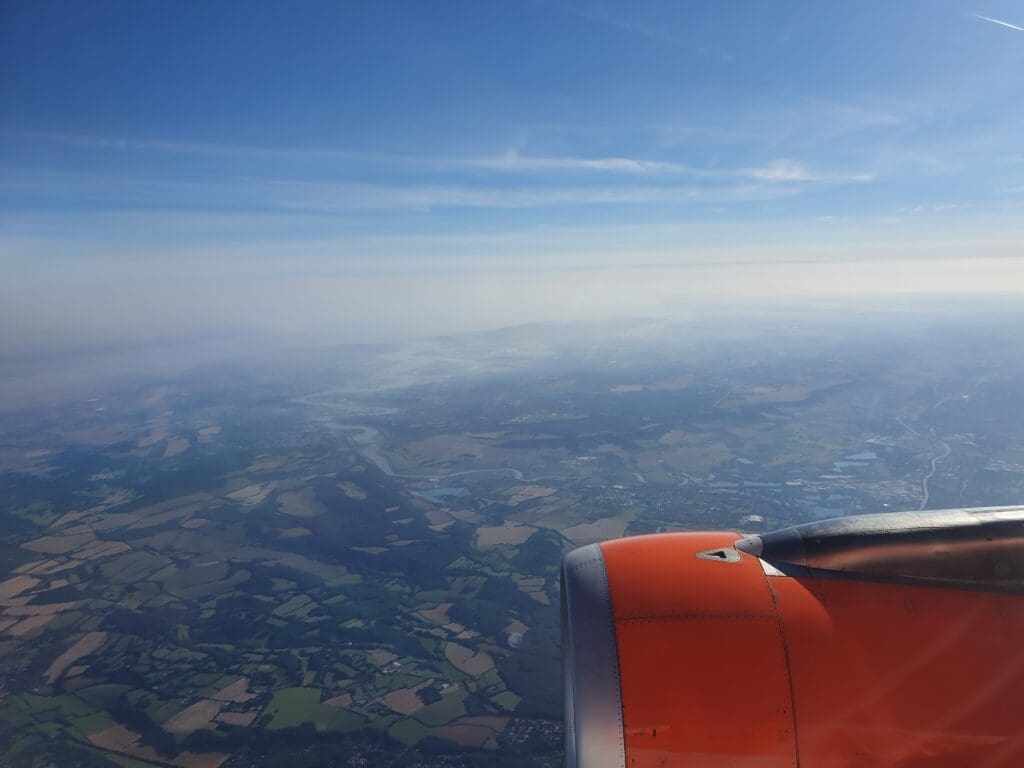
Turning my attention back outside, from Kent, the aircraft made a beeline for East London – passing directly over London City Airport. Whilst those on the left hand side of the airport were offered good views of Central London, I was instead treated to views of suburbia – specifically the neighbourhoods of Barking, East Ham, Wanstead, Woodford and Enfield. As the aircraft continued to fly north, these were then replaced by the brown, green and yellow fields as well as the occasional towns of the counties of Essex and Hertfordshire. As the aircraft neared Stevenage, the jet levelled off at its low cruising altitude of 26,000 feet as the trolley began to progress down the aisle.
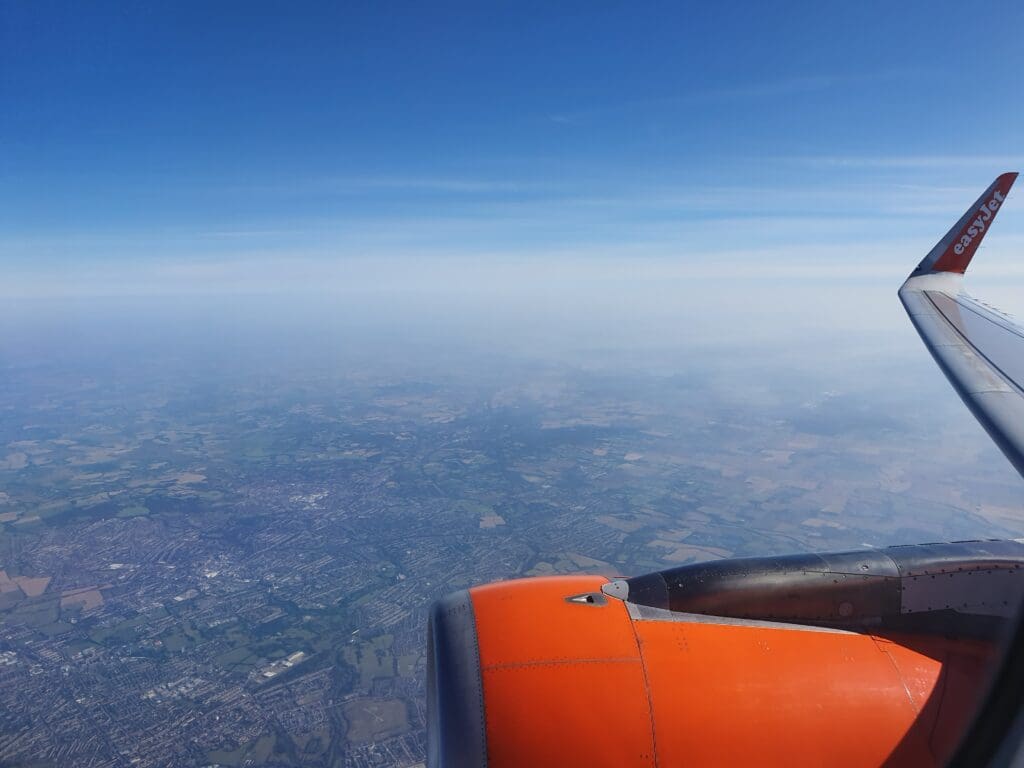
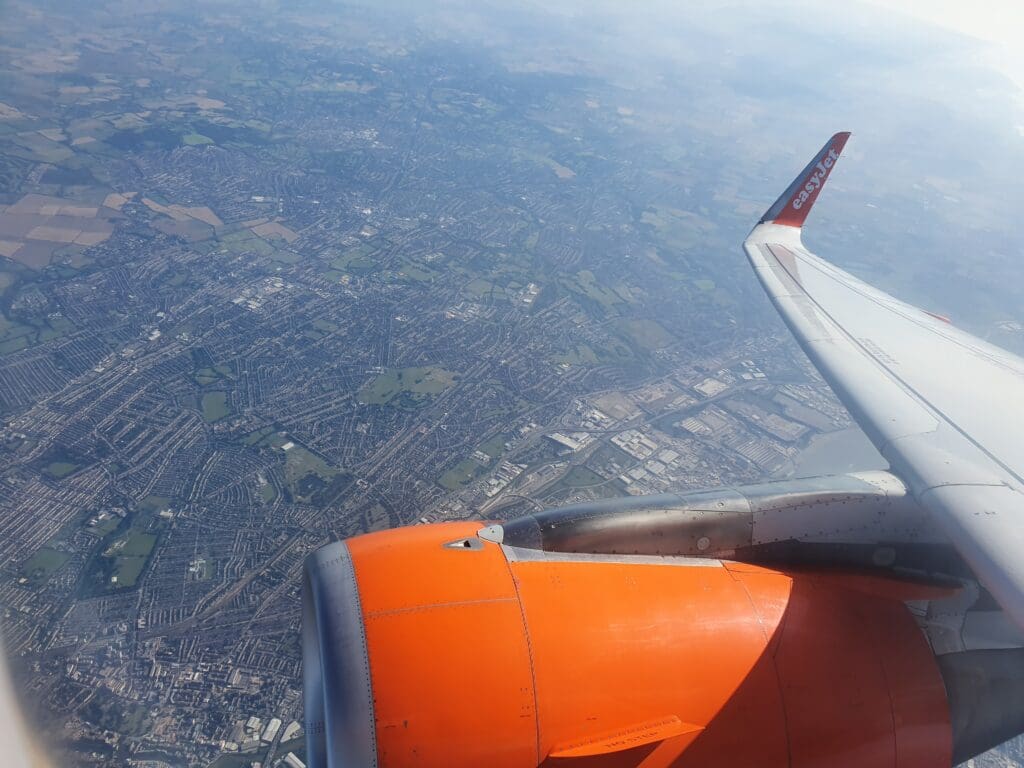
That morning, a good number of passengers appeared to be partaking in the Bistro service – with this appearing to prove far more popular than the BoB service onboard the morning Ryanair flight I had taken just over a week earlier. Whilst I cannot be certain of the availability of products onboard the flight that morning, the Bistro menu features a selection of hot and cold sandwiches, snacks and drinks as well as ‘light bites’, specifically MOMA porridge and Pot Noodles. In terms of prices, items offered were sold at the usual onboard inflated price, however savings could be made by combining items. For example, the ‘café deal’ offers a hot drink and a muffin, chocolate or shortbread for £4.00 (€4.50 or 5 Swiss Francs). Meanwhile when combined with a sandwich, snack and light drink combined are offered for £7.50. Whilst I decided to skip the BoB offerings, I did notice that the two crew members staffing the forward trolley were polite and friendly in their interactions with those passengers around me.
Meanwhile, turning my attention back to the outside world, by the time the trolley had passed my row, the Airbus was rapidly progressing northwards over the Midlands. After passing Bedford, the aircraft headed over Kettering and roughly followed the course of the M1 motorway, passing Leicester, Loughborough and then Nottingham before reaching Derbyshire. Whilst I had missed out on good views of London during the early stages of the flight, I did have a good reason to be thankful for my position on the right hand side of the aircraft. Following a short crossing of Derbyshire, the aircraft arrived at South Yorkshire – where my home city of Sheffield could be seen in full view. From our low cruising altitude I managed to spot all the city’s famous sites – including the stadiums of both Sheffield United and Sheffield Wednesday, the Meadowhall shopping centre, the city centre as well as the very road where I was born and where my parents still live! Strangely enough, in my 300+ flights, this was the very first time in living memory I had ever actually seen my home city from the air.
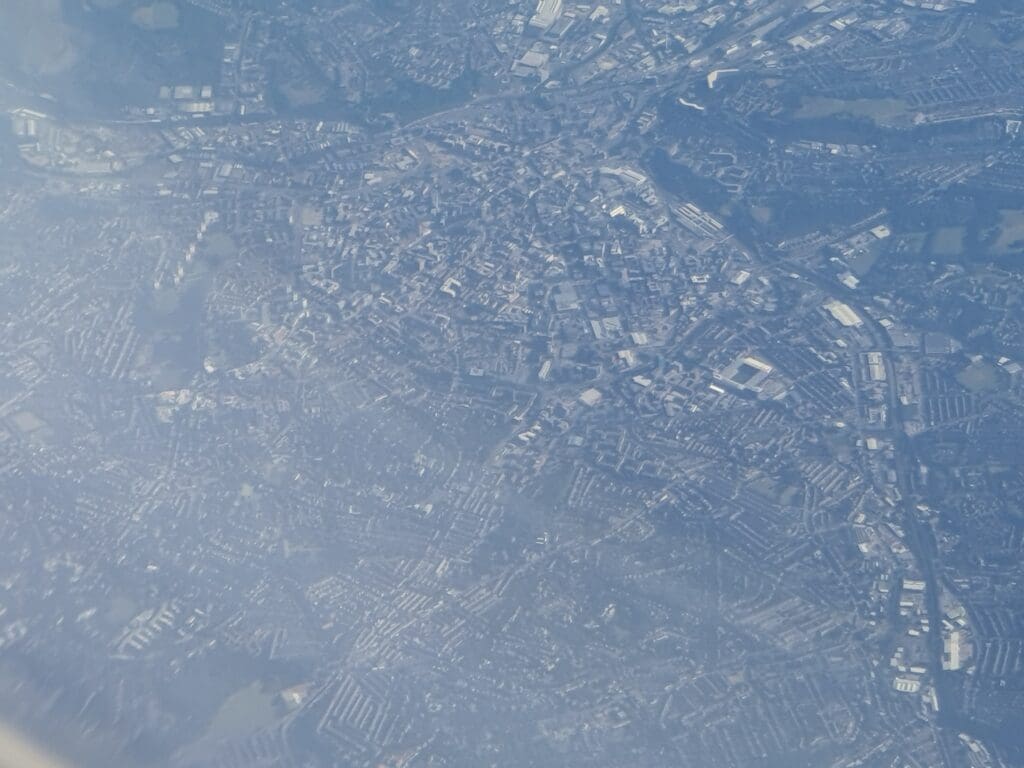
Seeing as I would likely not get the opportunity to do so otherwise, at this stage in the flight, I decided to make a quick trip to the lavatory at the front of the cabin. Managing to enter this without any queuing, I found this to be fairly small yet in a seemingly clean condition if not very slightly battered. Unlike the lavatory on one of the airline’s recently delivered A320neos I had sampled earlier in the year, this appeared to be decked out with orange trimmings that serve as a clear reminder to passengers of the airline they are flying on.
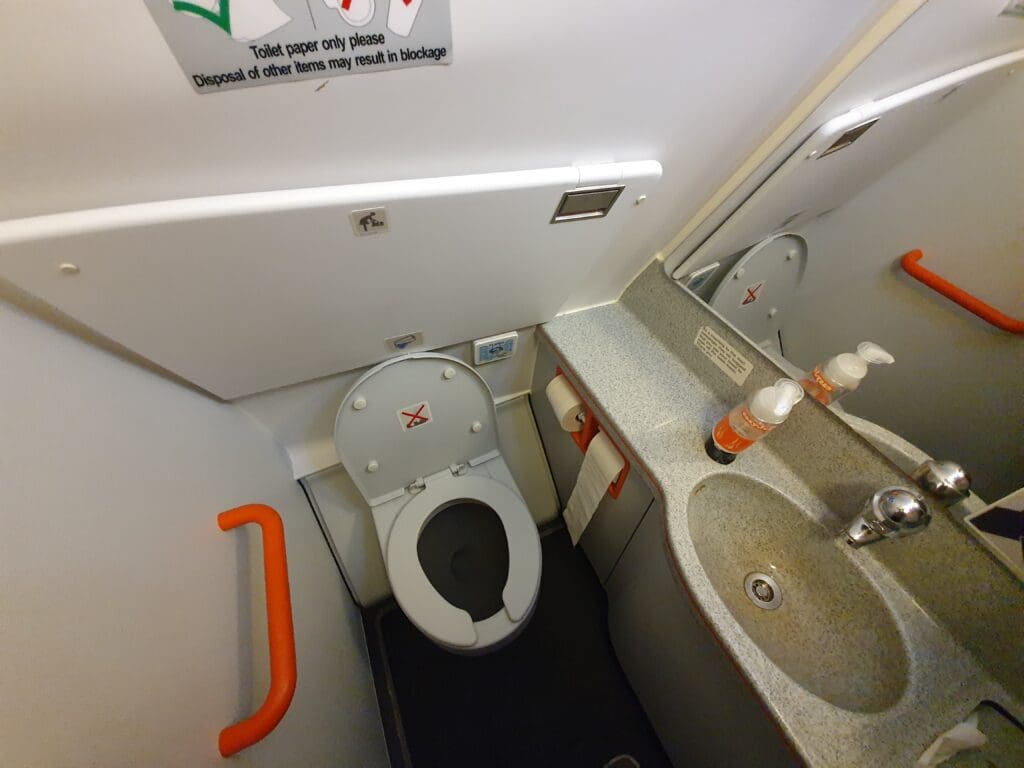
By the time I squeezed back into my seat, the aircraft had made its way past Leeds and Bradford and the green rolling fields of the Yorkshire Dales National Park, and then the North Pennines could be seen beneath the aircraft. Meanwhile, for those on the left hand side of the aircraft, this was followed by a view of the scenic Lake District National Park. As the aircraft approached the town of Kendal, at 0955 the jet could be felt gently commencing its descent into Glasgow. Meanwhile, this was accompanied by an announcement by the purser requesting donations for EasyJet’s charity partnership with UNICEF’s Covid-19 vaccination campaign.

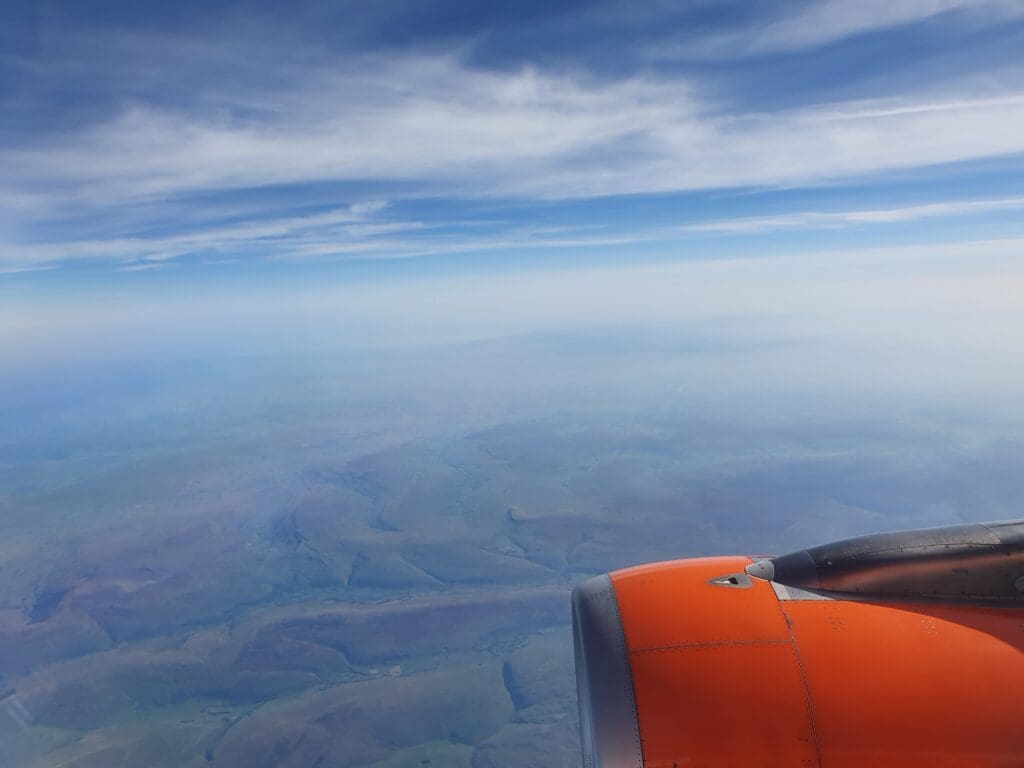
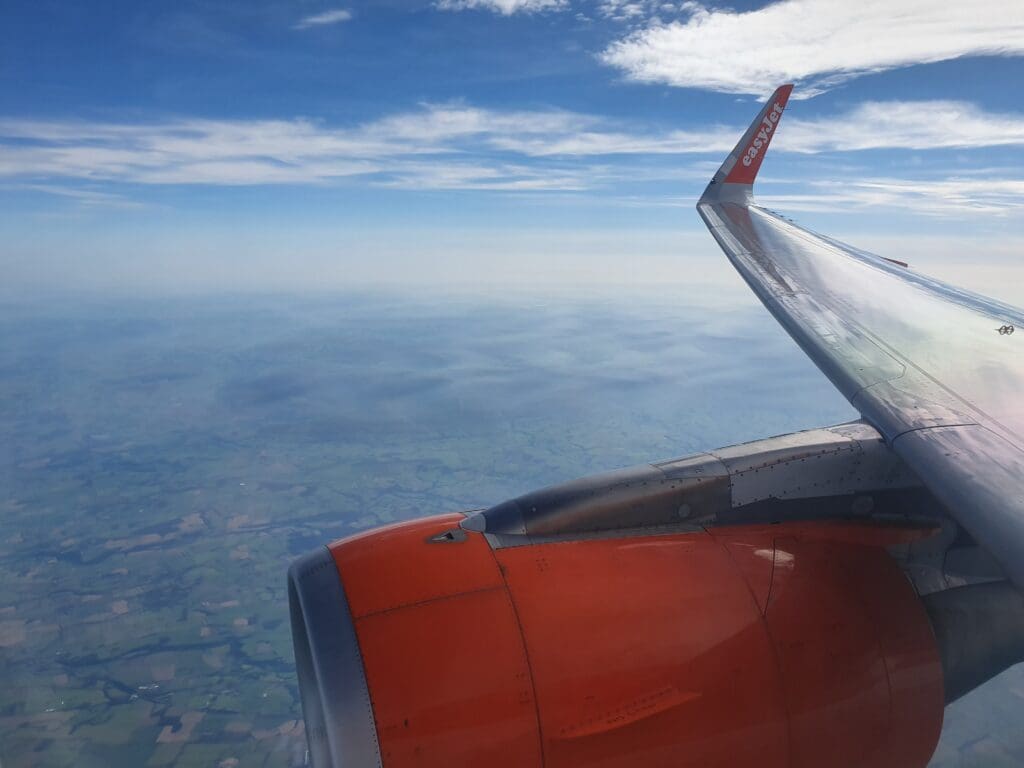
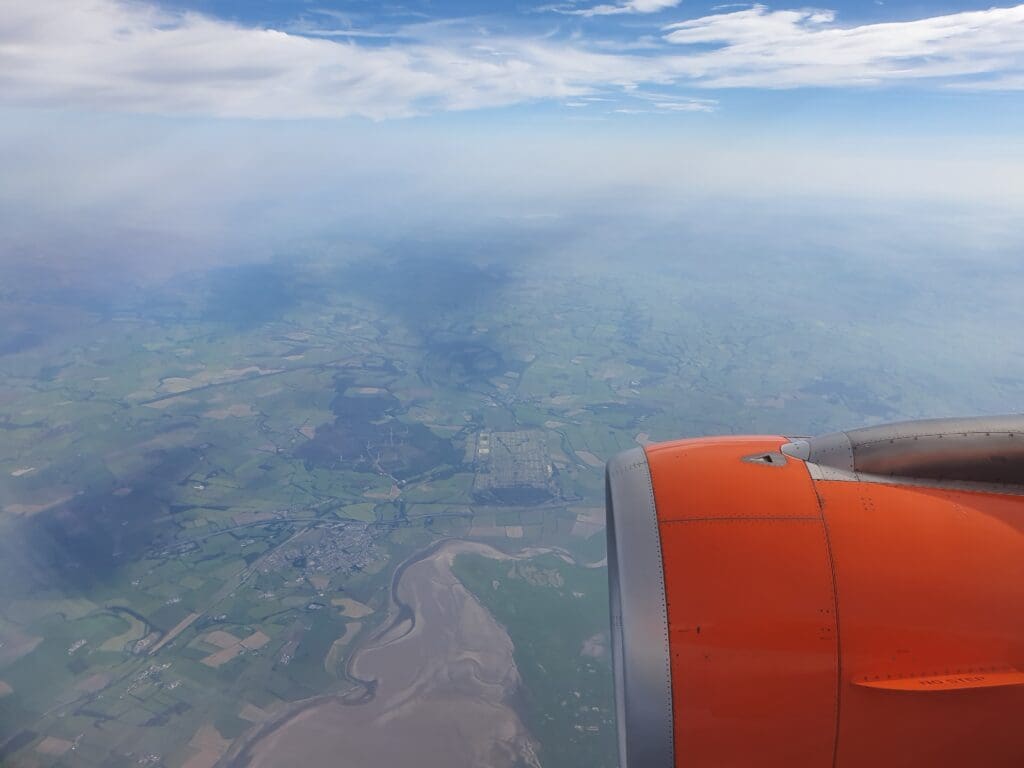
As the aircraft sank lower, the English town of Carlisle sitting just to the south of the border with Scotland came into view before the jet headed across the Solway Firth and out over Scotland. Following the course of the A74 road, during this time little could be seen outside the aircraft bar the occasional town and the scenic hilly scenery below the aircraft, whilst inside the cabin the seatbelt signs were soon reilluminated. At this stage, the Purser performed their pre-arrival announcement and the crew passed around the cabin collecting rubbish and performing their final safety checks before strapping themselves in with plenty of time to go until our arrival.
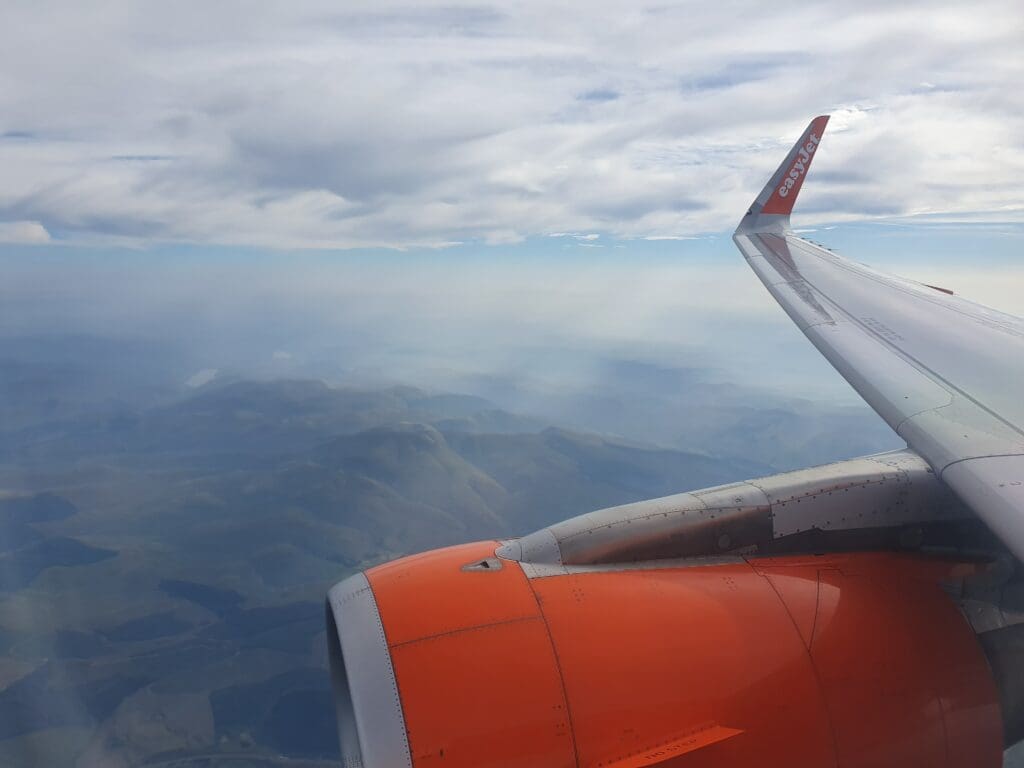
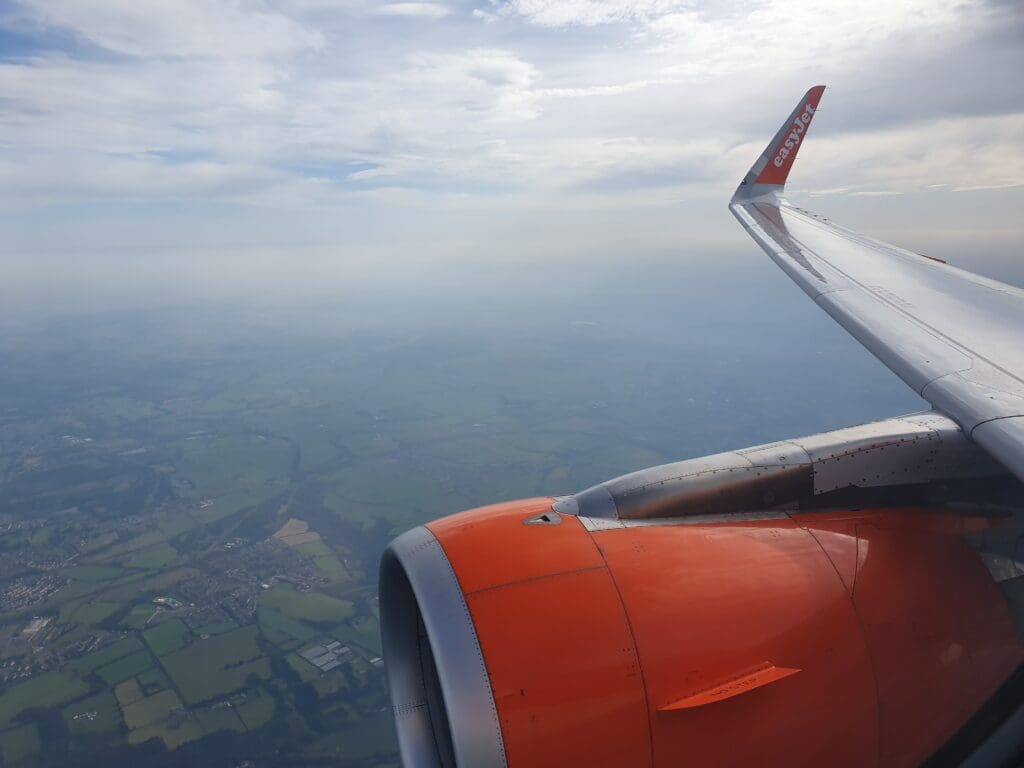
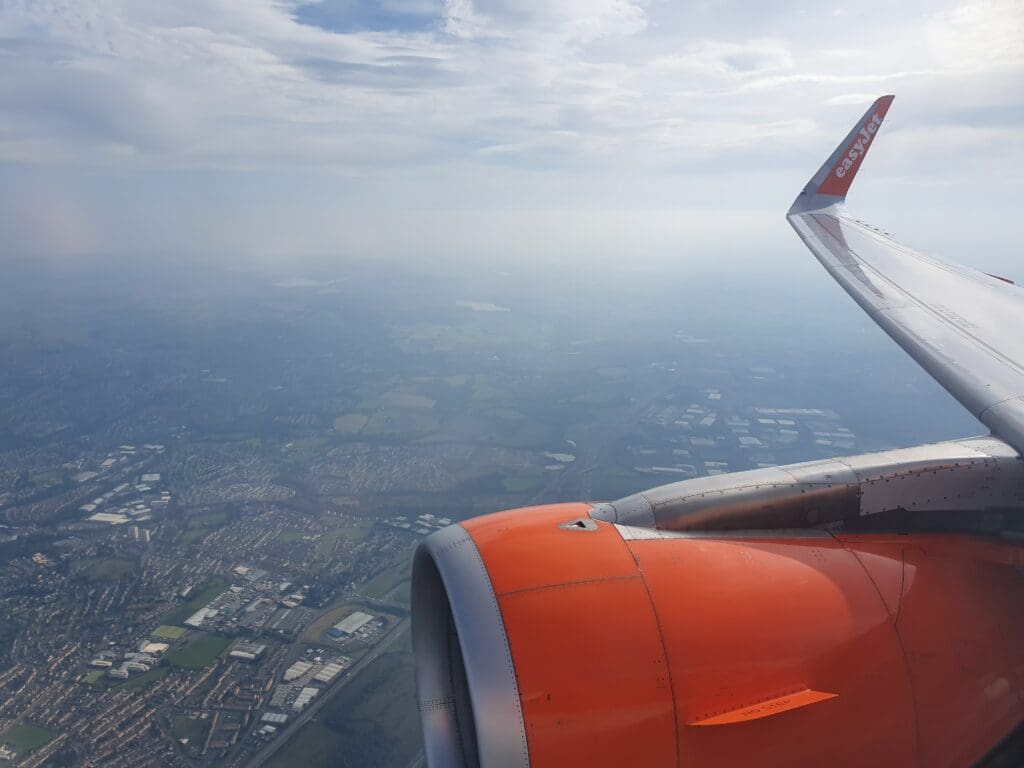
After passing over Hamilton, Kirkintilloch and Cumbernauld, the scenery beneath the aircraft rose up once again in the form of the Campsie Fells, where patches of low-lying cloud could be seen lingering below. At this stage, the aircraft turned to line itself up for an approach to Glasgow Airport’s Runway 23 as the flaps and gear were extended in preparation for our arrival. As the aircraft neared Glasgow, the landscape flattened once again and the fields were replaced by the city’s northern suburbs and soon enough the River Clyde popped into view.
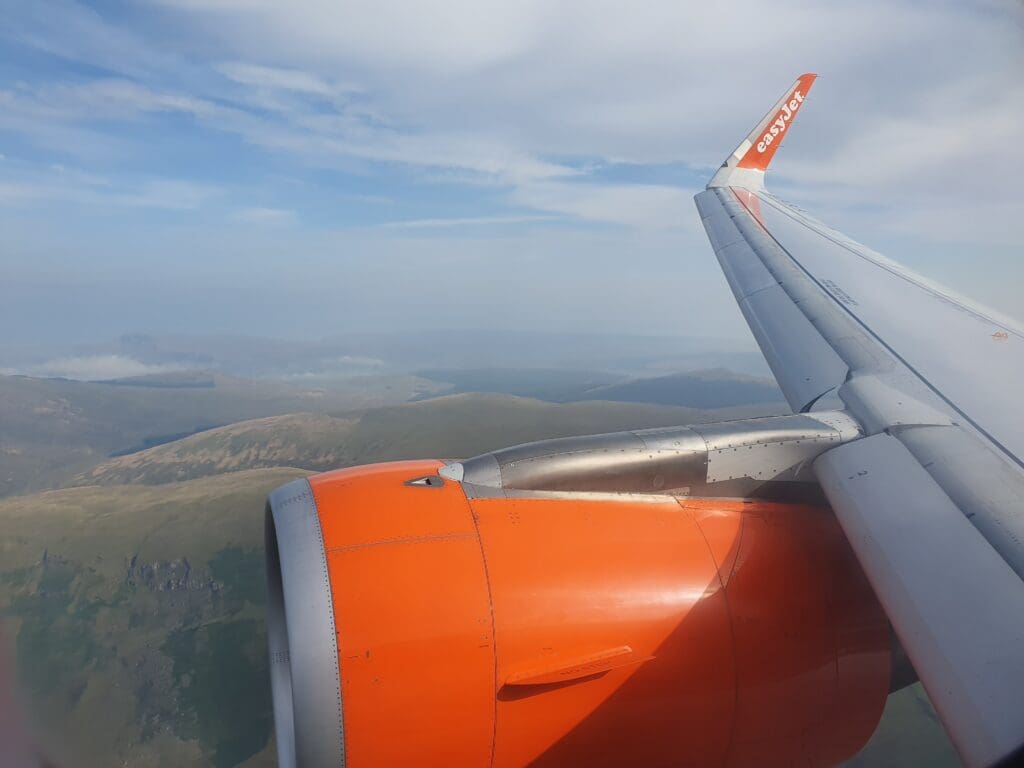
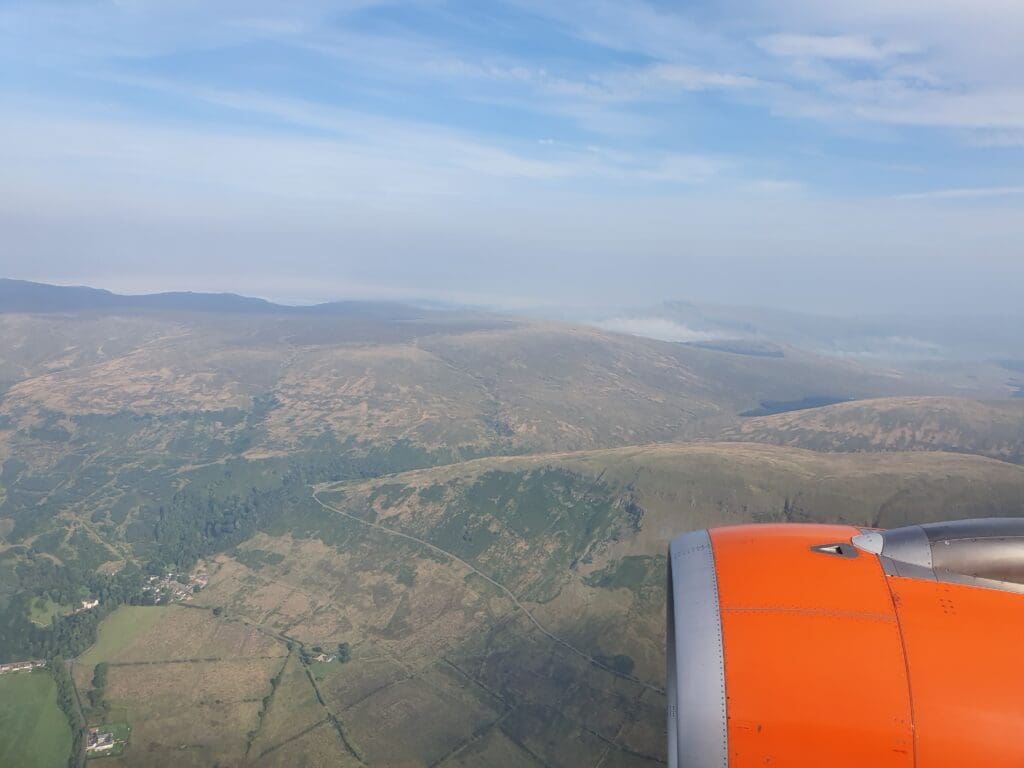
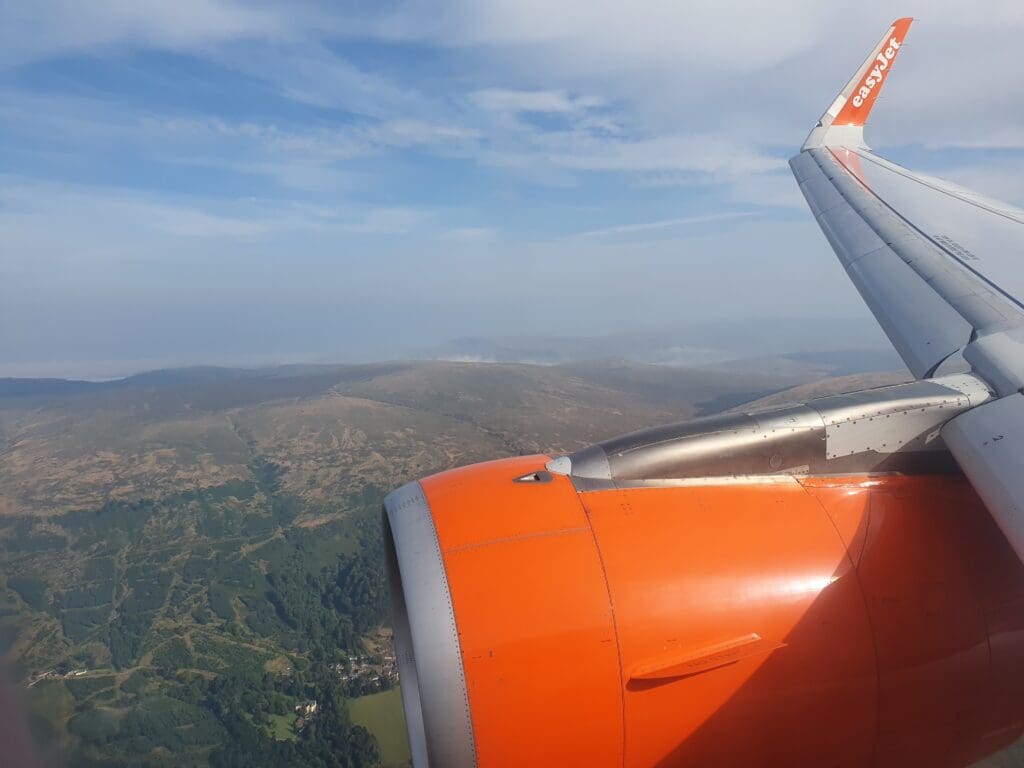
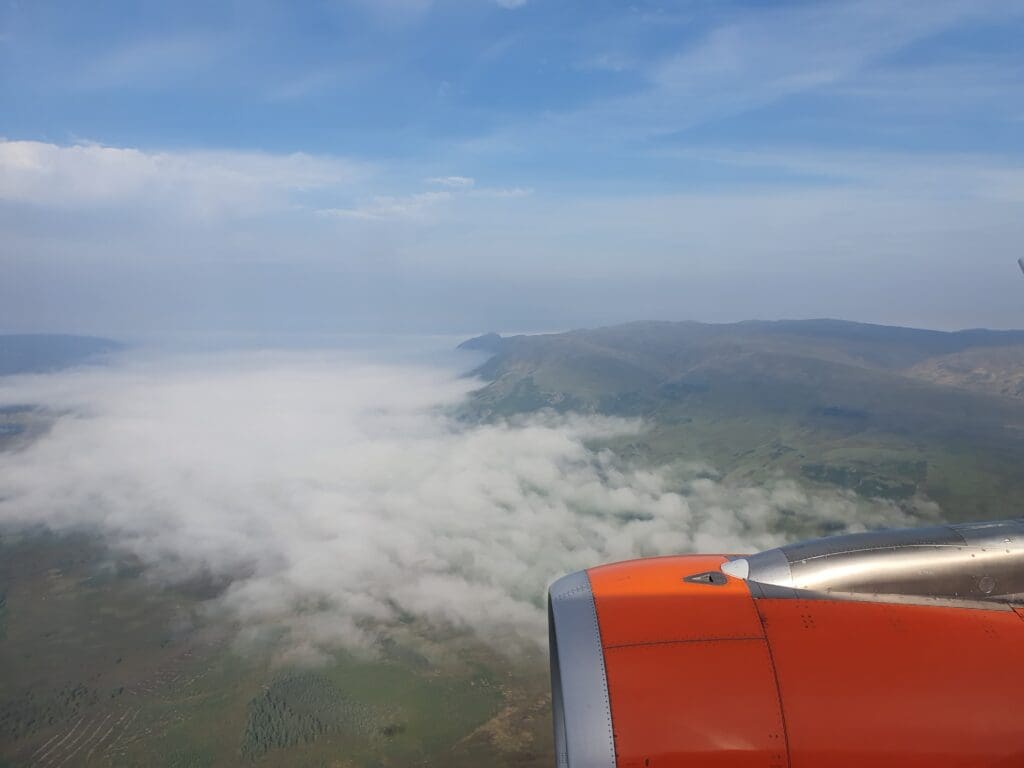
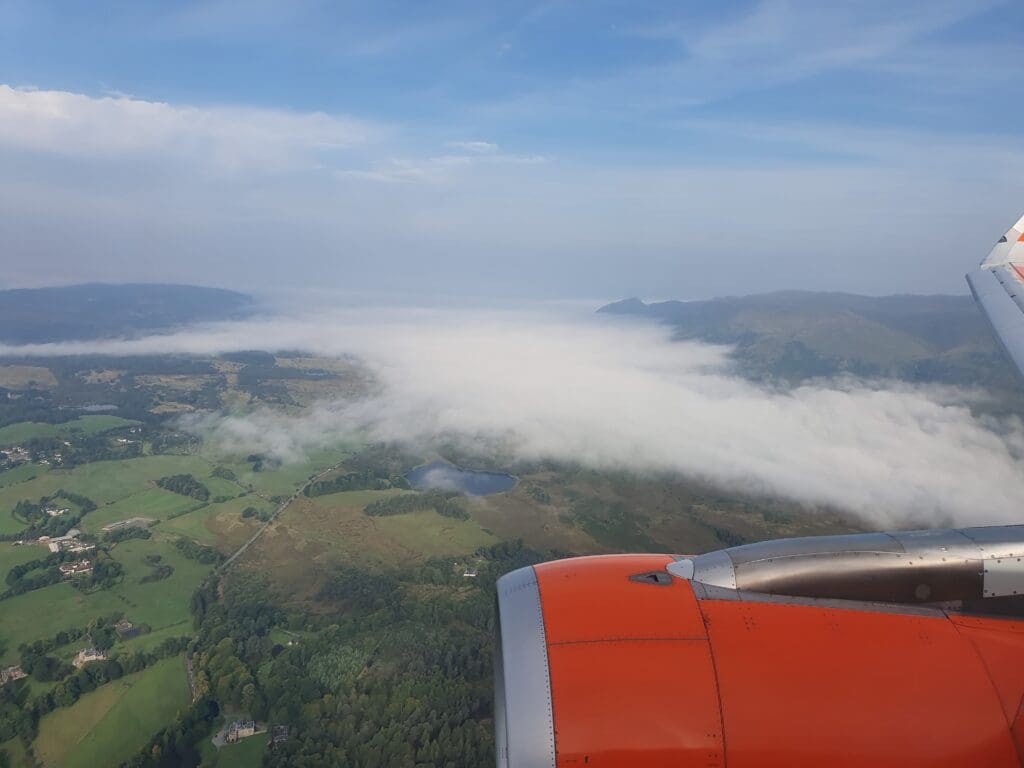
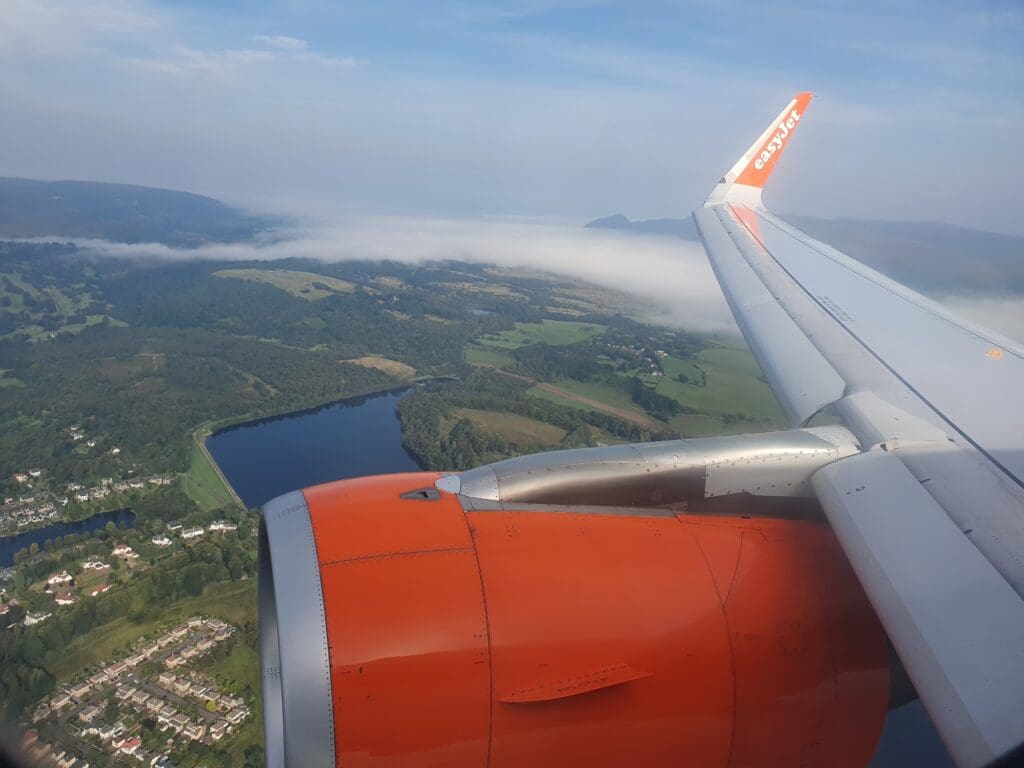
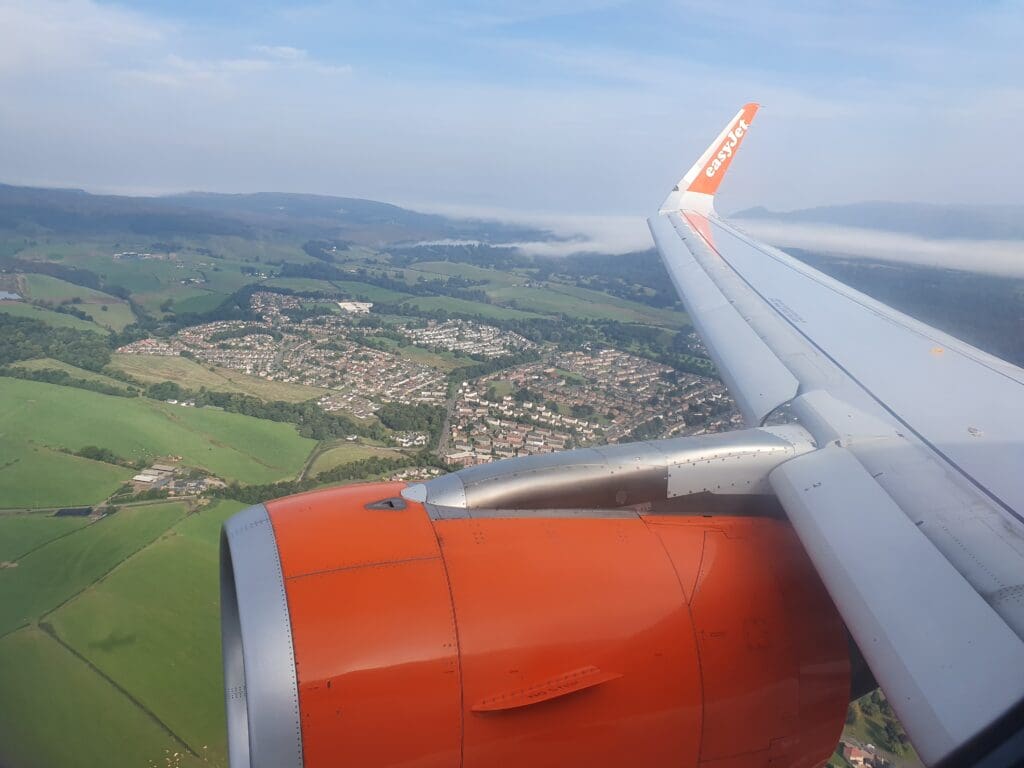
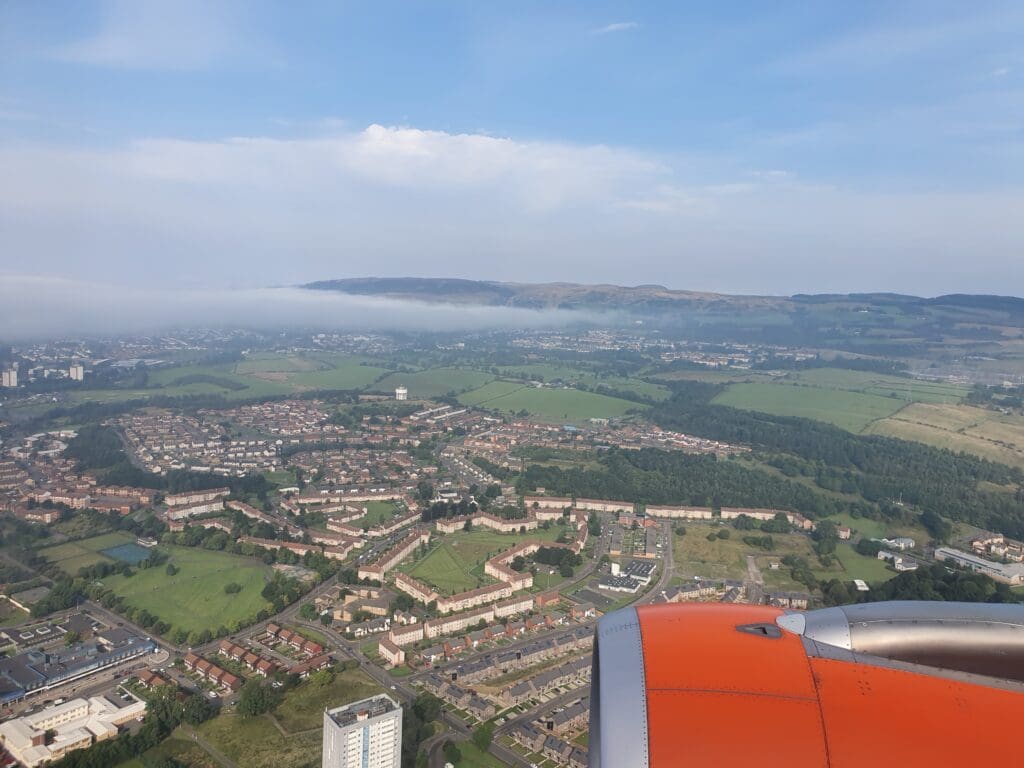
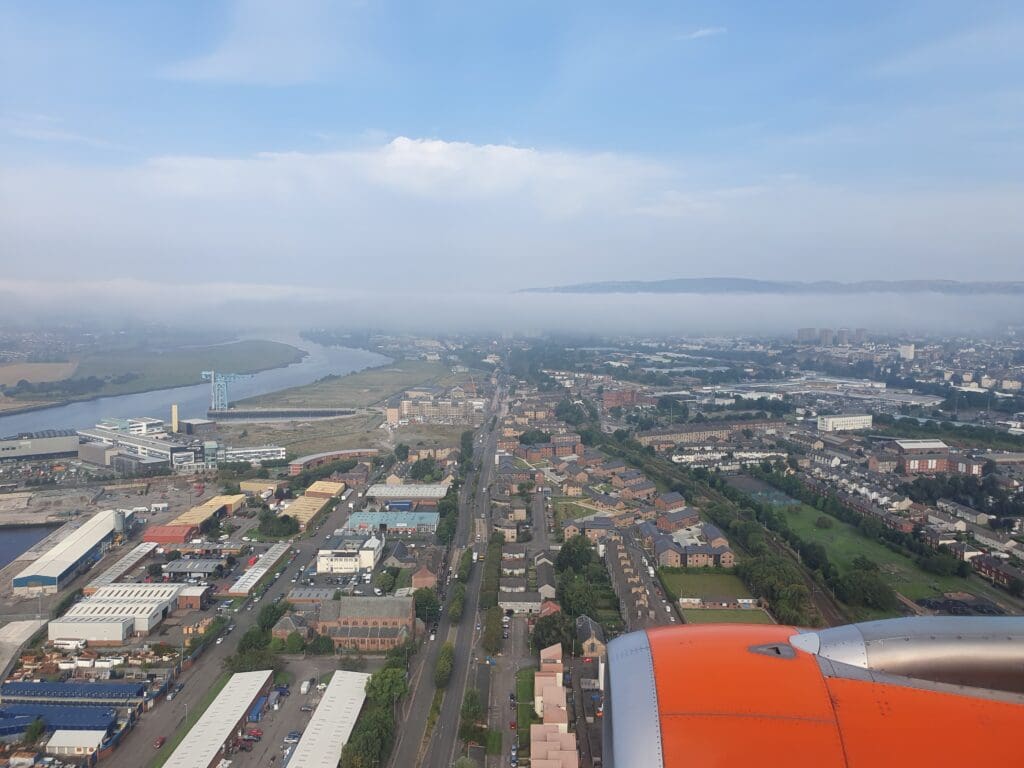
Seconds after darting across the Clyde, the Airbus crossed Glasgow Airport’s perimeter fence and at 1022, 1H01 after leaving Gatwick, performed a gentle touchdown on the runway. This was then followed by some rather harsh braking whilst I was treated to a view of the locally based light aircraft before the jet taxied left off the runway. Immediately after leaving the runway, Loganair’s hangar popped into view where three Saab 340s could be seen undergoing maintenance, whilst near this on a remote stand French registered Embraer 135 belonging to Pan Européenne Air Service could be seen resting having operated a charter service up from Geneva.
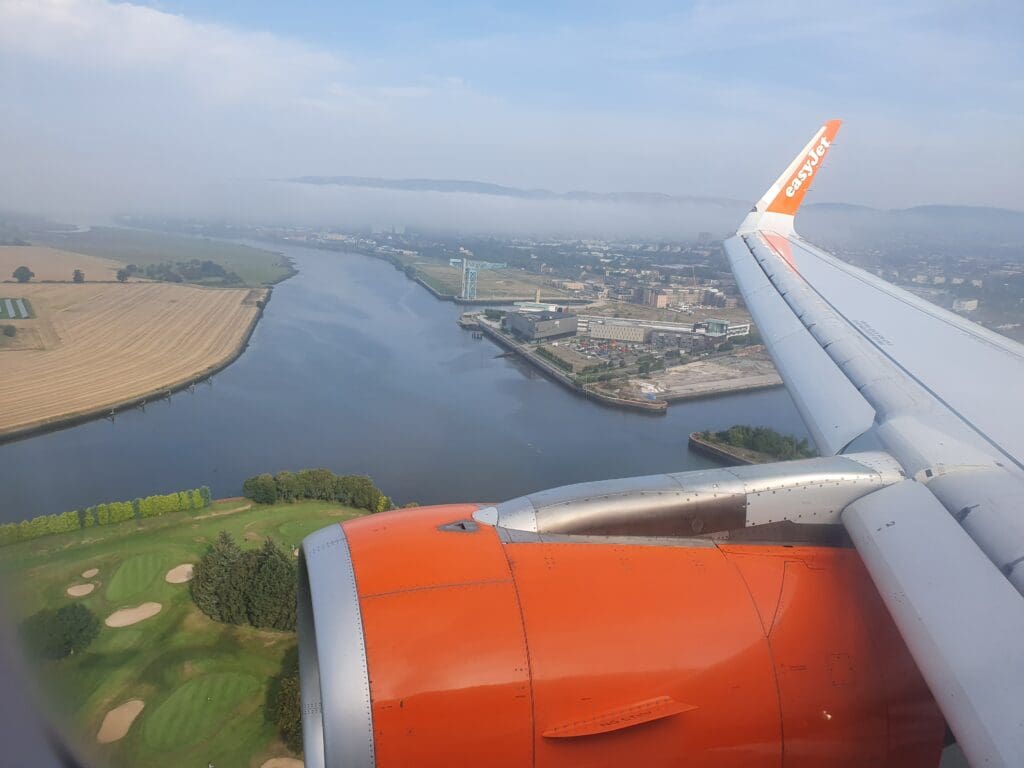
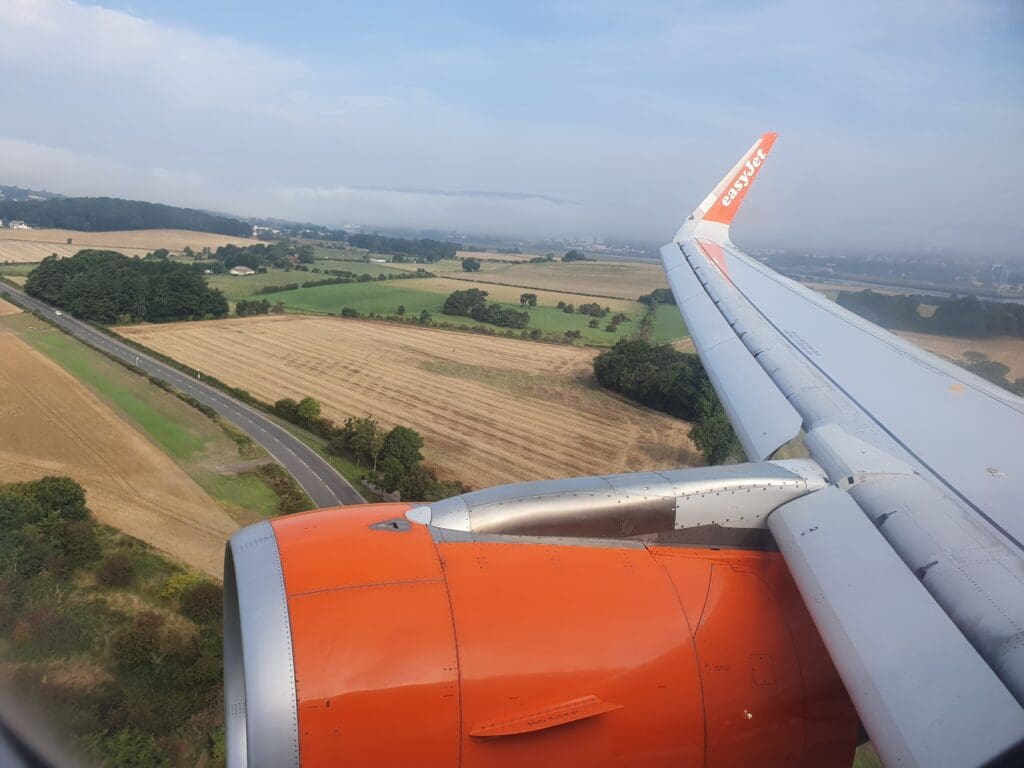
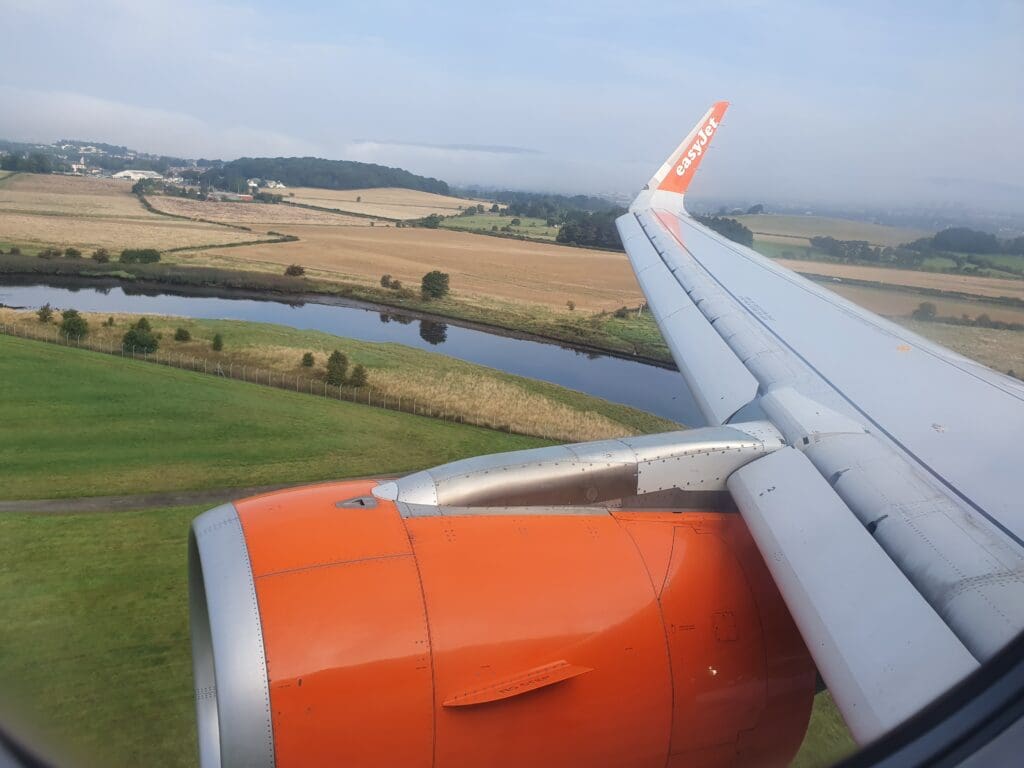
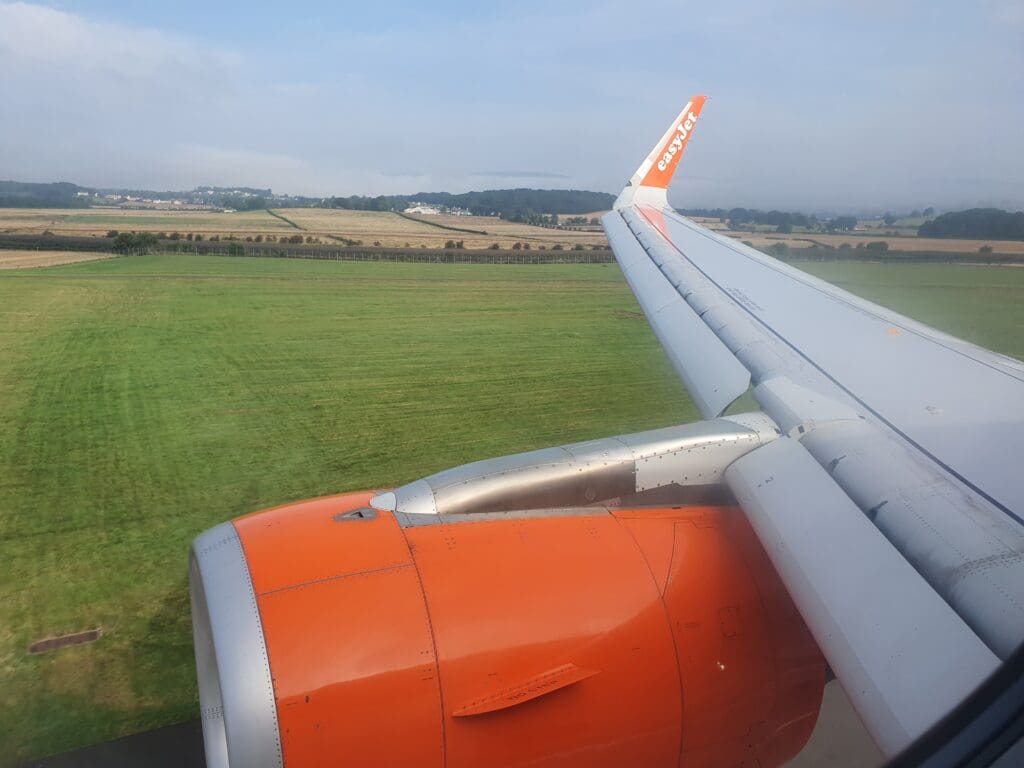
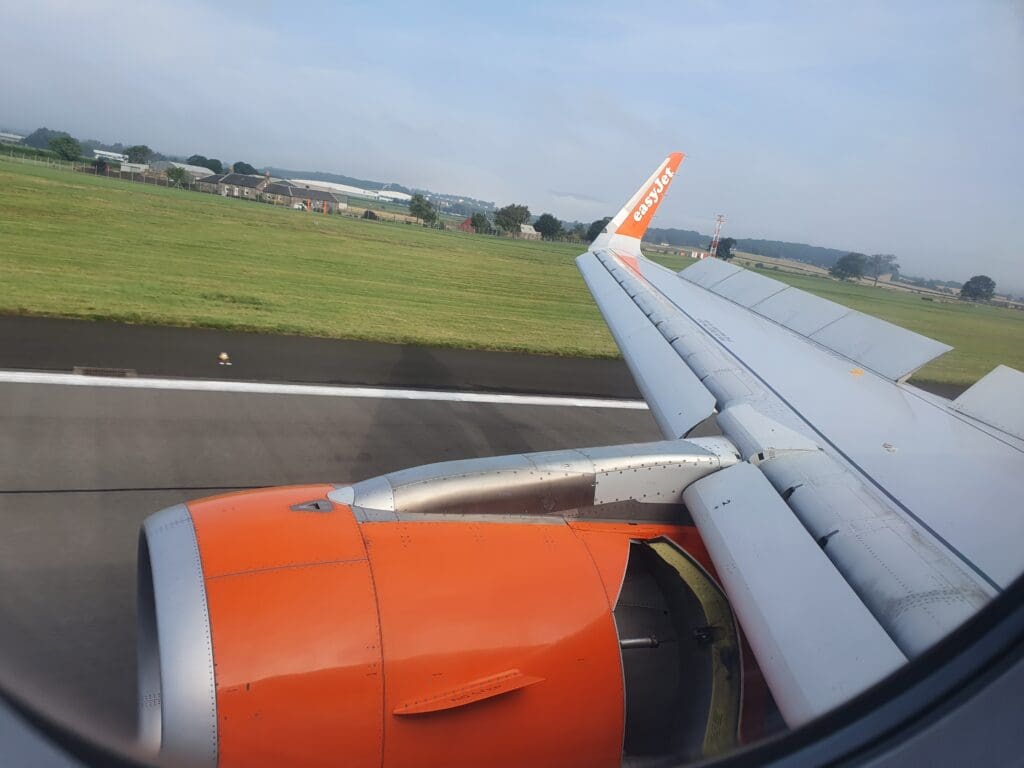
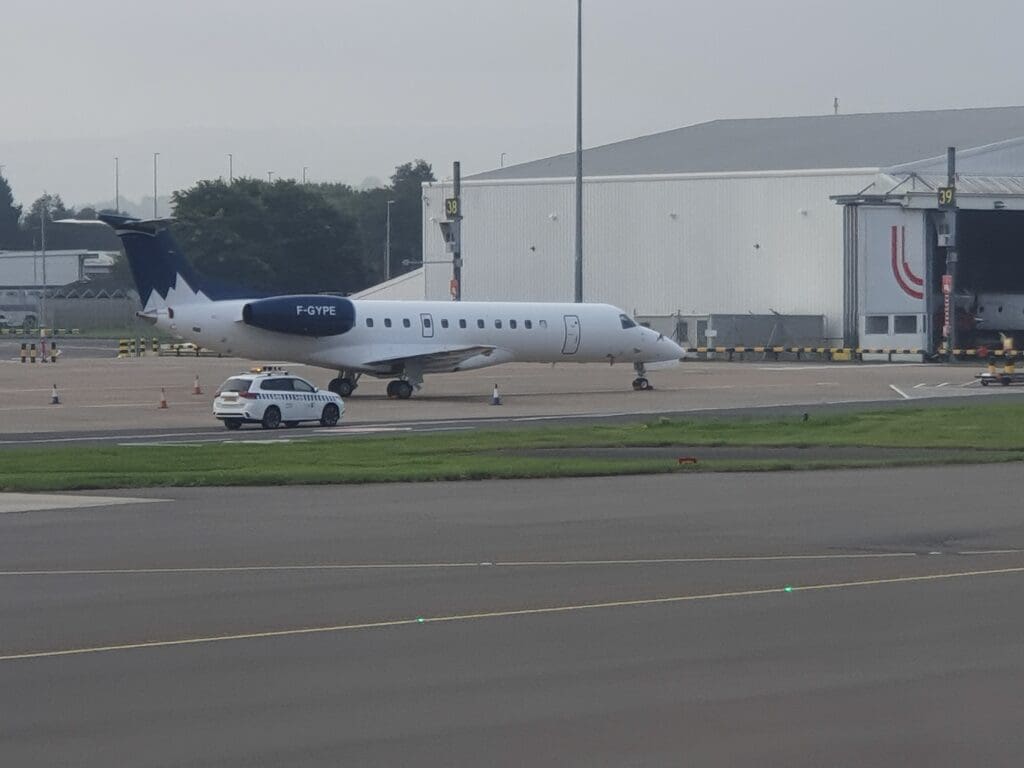
That morning, having arrived following the morning rush, the terminal appeared to be a little barren for its size. Standing outside there were two Jet2 Boeing 737-800s, a few EasyJet aircraft, a couple of Loganair Embraer 145s and a single Twin Otter. At 1025, the Airbus cautiously taxied into stand 10, pulling up next to a Loganair jet which immediately pushed back for its flight down to Exeter. As is often the case, it appeared as if many were in a rush to exit the aircraft that morning, with most of those at the front of the cabin standing up as soon as the engines were shut down. Despite my fellow passengers’ rush to leave the aircraft, the L1 door was not opened for another five minutes, at which point disembarkation commenced.
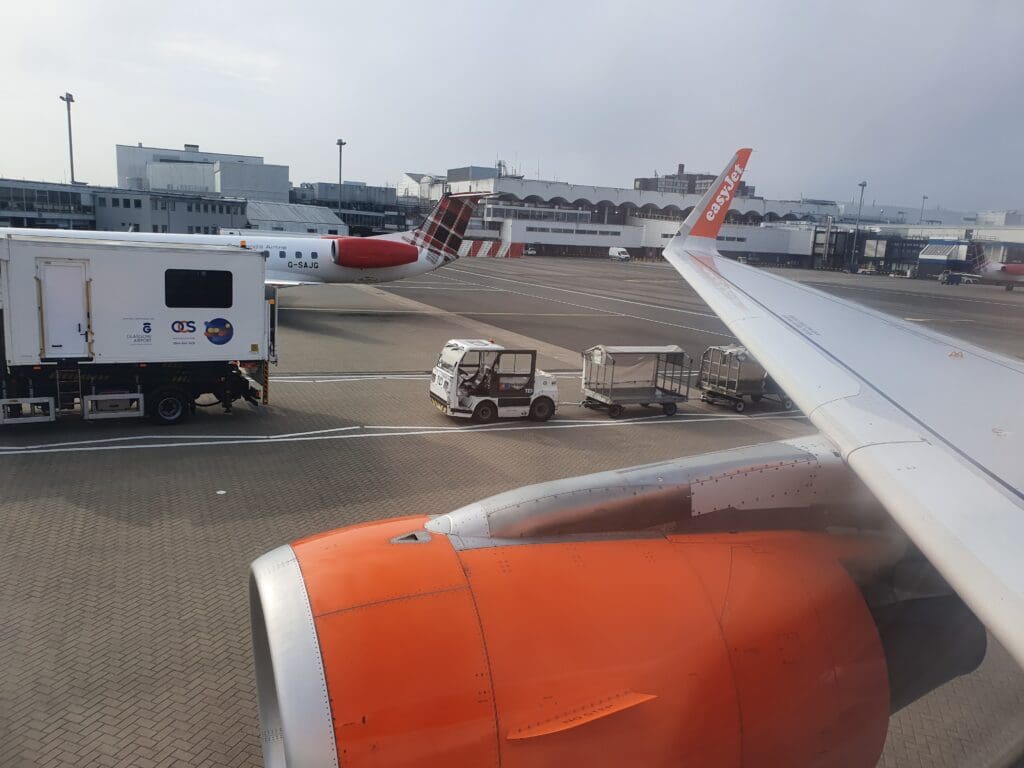
Once the cabin door had been opened, disembarkation was a quick process and within a couple of minutes, I found myself thanking two of the friendly crew members before heading out into the warm morning air. After taking a couple of quick pictures, I entered the terminal at ground floor level and began the quick walk through the airside combined arrivals-departures area before making my way down the escalators to the baggage claim area and walking through to the landside arrivals hall – my journey from aircraft to landside area taking no more than a couple of minutes.
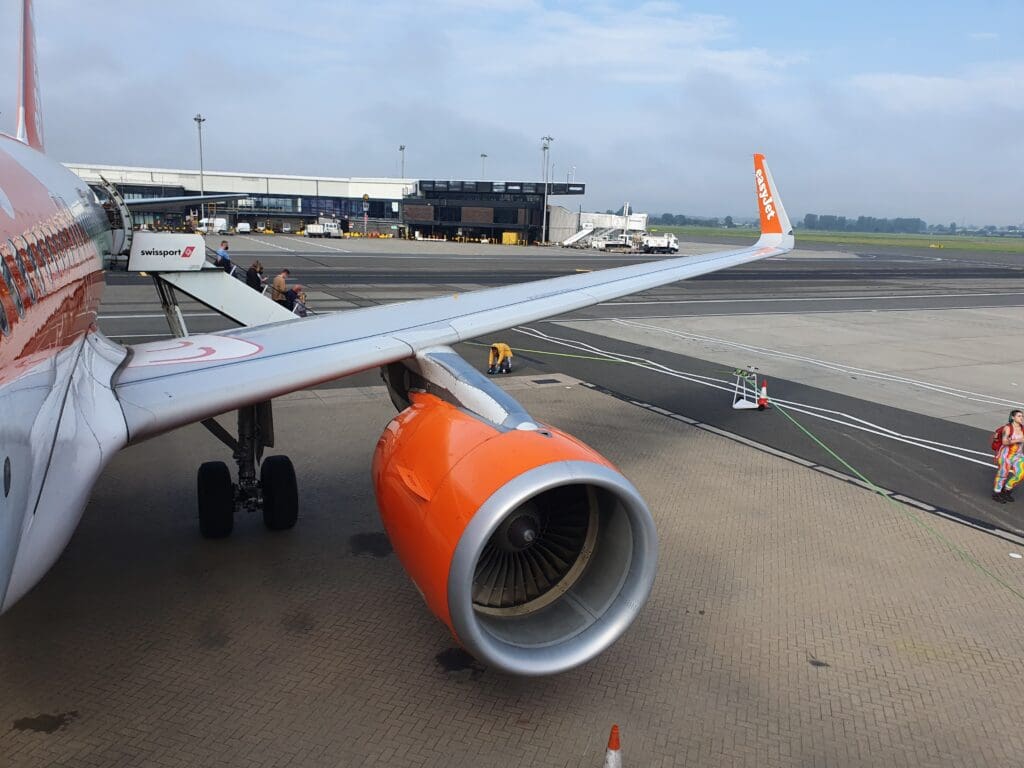
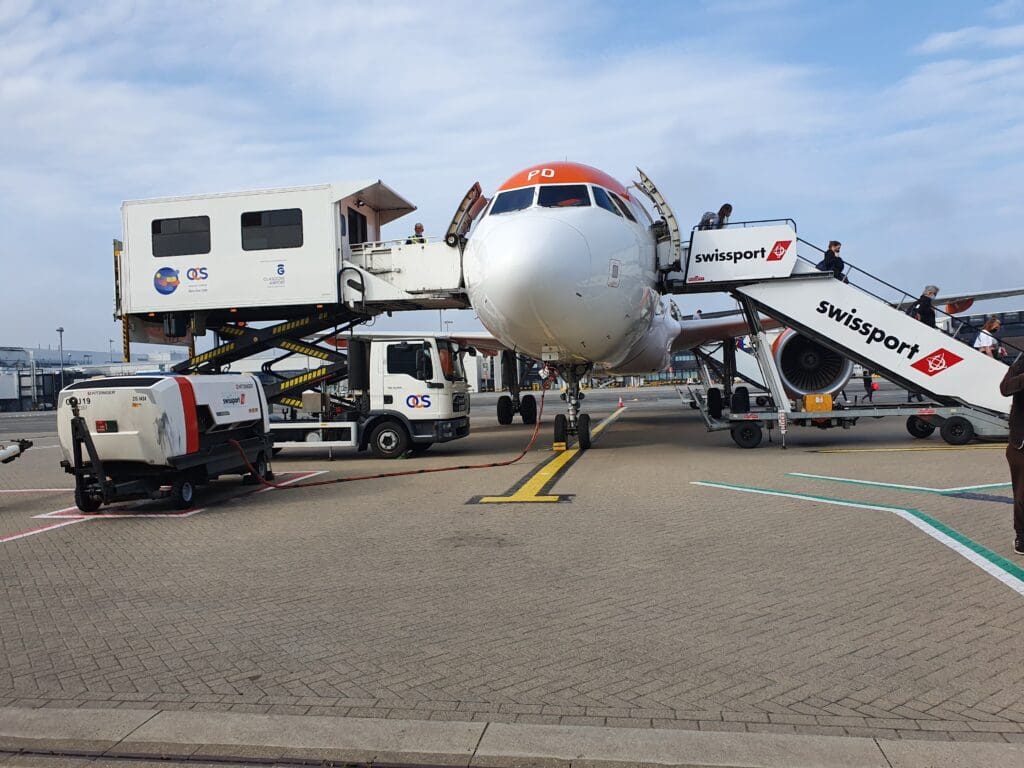

Conclusion
Once again, EasyJet left me with very little to complain about. Whilst I suspect that their seats may not prove particularly comfortable on a longer flight, they were perfectly adequate for a flight time of only a smidgen over an hour. Importantly, the cabin appeared to be in good shape, the crew were exceedingly polite and friendly, the ticket was cheap and I arrived ahead of schedule and in one piece. Thus, to conclude, my experience with EasyJet that morning left me with absolutely no reason not to fly with the airline again.

